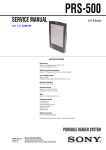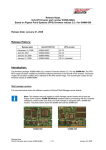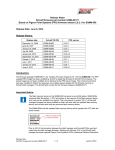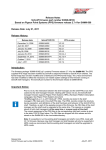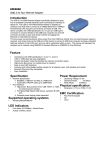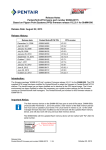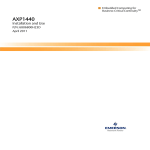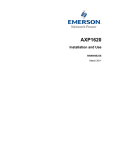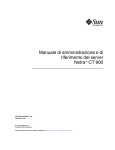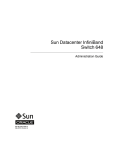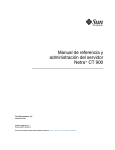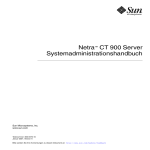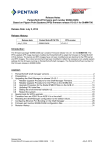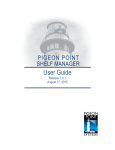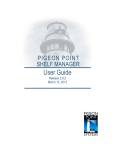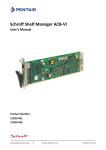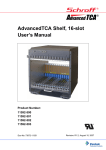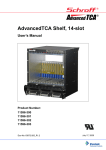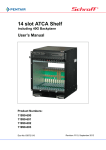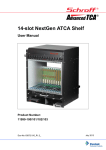Download Release Notes Schroff firmware part number 63998
Transcript
Release Notes Schroff firmware part number 63998-08160 Based on Pigeon Point Systems (PPS) firmware release 2.6.4.4 for ShMM-500 Release Date: January 29, 2010 Release History: Release date December 14, 2006 April 26, 2007 January 18, 2008 July 28, 2008 January 29, 2010 Schroff FW P/N 63998-04652 63998-04660 63998-04664 63998-08152 63998-08160 PPS version V2.3.2 V2.4.2 V2.5.1 V2.5.3 V2.6.4.4 Introduction: The firmware package “63998-08160.zip” contains Firmware release 2.6.4.4 for the ShMM-500. The PPS supplied RFS image has been modified by Schroff to adapt the firmware to Schroff ATCA shelves. The kernel image has not been modified and is identical to the PPS kernel image. The U-boot environment has been modified to reflect the necessary non-volatile system settings for this firmware running on Schroff shelf managers. The Schroff part number for this firmware release is 63998-08160. Important Notice: Prior to V2.5.3 the interaction between the shelf manager and the shelf FRUs was hard coded into the shelf manager firmware. Starting with Version V2.5.3, the Schroff shelf manager firmware supports Pigeon Point Systems HPDL (Hardware Platform Description Language). See Pigeon Point Systems document “ShelfManagerUG_2_6_4_4_20091213.pdf”. HPDL records are stored in the shelf manager’s FRU data and in the shelf FRU data. The HPDL records contain the structure, device population, and definitions of the shelf hardware and behavior of the Schroff ATCA shelf. Therefore, as part of the upgrade process of the firmware, the FRU files of the shelf manager and the shelf must be upgraded at the same time. This requires a complete reboot of both shelf manager(s) at the same time or a power cycle of the shelf. The correct assignment of the FRU files to the corresponding shelf part number is given in the table ‘FRU ID Files’ below. The FRU files are shipped with this release and are stored on the ShMM-500 in the /var/nvdata directory. Note: It is possible to run the existing shelf managers and shelf in non-HPDL mode with V2.6.4.4 firmware. Because new shelf manager and shelf designs will only be supported in HPDL mode we recommend that the existing shelf managers and shelf be upgraded to HPDL mode. CONTENT: 1 2 3 Schroff shelf manager versions ............................................................................................ 3 Preparations ......................................................................................................................... 5 Upgrading the Shelf Manager to release 2.6.4.4 .................................................................. 9 3.1 Reliable Upgrade Procedure....................................................................................... 11 3.2 TFTP Upgrade Procedure........................................................................................... 16 3.3 Updating FRU data files.............................................................................................. 19 3.4 Setting the environmental variable rc2........................................................................ 21 3.5 Restart the system ...................................................................................................... 21 Release Note Schroff Firmware part number 63998-08160 1 / 40 January 29, 2010 4 5 6 7 8 Special tests for HPDL upgrade: ........................................................................................ 22 Resetting the Shelf Manager configuration to the default values........................................ 24 Configuring Ethernet Port Bonding on the Shelf Manager.................................................. 27 Firmware part number 63998-08160 configuration files ..................................................... 28 Revision History.................................................................................................................. 30 Release Note Schroff Firmware part number 63998-08160 2 / 40 January 29, 2010 1 Schroff shelf manager versions The table below shows the Schroff shelf manager versions, please identify your shelf manager type. You will need the corresponding RC2-variable later in the upgrade process. Photo Type RC2-variable ACB-V rc.acb-HPDL ACB-IV rc.acb-HPDL ACB-III rc.acb3 The part number of the ACB-V shelf manager is on the label at the rear side of the shelf manager, see photo below: - Radial IPMB version: p/n = 21596-292 - Bused IPMB version: p/n = 21596-291 Note: If you have this shelf manager in your Zephyr or Ventus shelf please follow the special upgrade instructions. The part number of the ACB-IV shelf manager is on the label at the rear side of the shelf manager, see photo below: - Radial IPMB version: p/n = 21594-347 - Bused IPMB version: p/n = 21594-346 The part number of the ACB-III shelf manager is on the label at the rear side of the shelf manager, see photo below: - Radial IPMB version: p/n = 21593-251 - Bused IPMB version: p/n = 21593-250 Release Note Schroff Firmware part number 63998-08160 3 / 40 January 29, 2010 The following Shelf Manager types originally shipped with ShMM-300 modules but might have been upgraded to ShMM-500 modules by the customer For upgrade instructions, please contact your Schroff service partner. Release Note Schroff Firmware part number 63998-08160 4 / 40 ACB-III rc.acb3e ACB-II ACB-II with ShMM-500 rc.acb2 rc.acb2-HPDL SMC-1 rc.acb-es January 29, 2010 2 Preparations Firmware files Unzip the file 63998-08160.zip. This file contains the following Pre-Built images: TFTP Upgrade files: 63998-08160.kernel 63998-08160.rfs Reliable Upgrade files: 63998-08160.shmm500.kernel 63998-08160.shmm500.rfs 63998-08160.u-boot.bin Upgrade kernel image for TFTP upgrade Upgrade RFS image for TFTP upgrade Upgrade kernel for reliable upgrade Upgrade RFS for reliable upgrade Upgrade u-boot for reliable upgrade Terminal Program Connect a serial console cable to a terminal or PC running a terminal emulator (Hypercom, Minicom, HyperTerminal etc) to the serial interface of the Shelf Manager (RJ45 connector “SERIAL” or “ShMgr” on the SAP). Set the terminal or emulator to 115200, N, 8, 1 (115200 baud, no parity, 8 bits per character, 1 stop bit). Login user is “root” with no password. FRU ID files The Shelf Manager firmware images contain FRU ID files for the Shelf, Fan Trays, PEMs, SAP and the Shelf Manager for most production chassis. Important Note: This firmware release also contains updated shelf FRU data files. These FRU data files are stored in the /var/nvdata directory of the ShMM-500. The installation procedure of the FRU data files is described below. Please make sure to install these FRU data files after installing the new firmware image. Note: The FRU ID file name is comprised if the top assembly part number without the “-“, two letters representing the major and minor revision level, and “BIN.bin” indicating that the contents are binary. Shelf and shelf manager FRU ID files that are revision HA and higher support running the shelf managers in HPDL mode. The FRU ID files for the fan tray, PEM, or SAP do not contain HPDL and may have a revision level lower than HA. Note: If the FRU ID files that are already installed in your shelf or shelf manager are the same revision as those in the table below, they do not need to be upgraded. You can use the shelf manager command “clia fruinfo” to find the existing FRU ID file revision level in the “FRU Programmer File ID” field. FRU ID files included in firmware version 63998-08160: Shelf P/N 11596-090 New on 2.6.4.x 11596-100 11596-101 11596-102 FRU type Shelf FRU file Fan Tray FRU file SAP FRU file Shelf FRU file Fan Tray FRU file Fan Tray FRU file (new design) PEM FRU file SAP FRU file Shelf FRU file Fan Tray FRU file PEM FRU file SAP FRU file Shelf FRU file Fan Tray FRU file PEM FRU file Release Note Schroff Firmware part number 63998-08160 5 / 40 FRU ID file name 11596090HBBIN.bin 21596486AABIN.bin 21596077AABIN.bin 11596100HBBIN.bin 21596132ABBIN.bin 21990048AABIN.bin 21593312ABBIN.bin 21596134AABIN.bin 11596101HBBIN.bin 21596132ABBIN.bin 21593312ABBIN.bin 21596134AABIN.bin 11596102HBBIN.bin 21596132ABBIN.bin 21593312ABBIN.bin January 29, 2010 11596-103 11596-150 New on 2.6.4.x 11596-151 New on 2.6.4.x 11596-152 New on 2.6.4.x 11596-153 New on 2.6.4.x 11596-160 New on 2.6.4.x 11596-300 (Shelf Rev AB and higher) 11596-300 (Shelf Rev AA) 11596-301 (Shelf Rev AB and higher) 11596-301 (Shelf Rev AA) 11596-302 11596-303 11592-400 11592-401 11592-402 11592-403 11592-500 SAP FRU file Shelf FRU file Fan Tray FRU file PEM FRU file SAP FRU file Shelf FRU file Fan Tray FRU file PEM FRU file SAP FRU file Shelf FRU file Fan Tray FRU file PEM FRU file SAP FRU file Shelf FRU file Fan Tray FRU file PEM FRU file SAP FRU file Shelf FRU file Fan Tray FRU file PEM FRU file SAP FRU file Shelf FRU file Fan Tray FRU file PEM FRU file SAP FRU file Shelf FRU file Fan Tray FRU file PEM FRU file SAP FRU file Shelf FRU file Fan Tray FRU file PEM FRU file SAP FRU file Shelf FRU file Fan Tray FRU file PEM FRU file SAP FRU file Shelf FRU file Fan Tray FRU file PEM FRU file SAP FRU file Shelf FRU file Fan Tray FRU file PEM FRU file SAP FRU file Shelf FRU file Fan Tray FRU file PEM FRU file SAP FRU file Shelf FRU file Fan Tray FRU file PEM FRU file SAP FRU file Shelf FRU file Fan Tray FRU file PEM FRU file SAP FRU file Shelf FRU file Fan Tray FRU file PEM FRU file SAP FRU file Shelf FRU file Fan Tray FRU file PEM FRU file SAP FRU file Shelf FRU file Fan Tray FRU file PEM FRU file Release Note Schroff Firmware part number 63998-08160 6 / 40 21596134AABIN.bin 11596103HBBIN.bin 21596132ABBIN.bin 21593312ABBIN.bin 21596134AABIN.bin 11596150HBBIN.bin 21990022AABIN.bin 21593312ABBIN.bin 21596134AABIN.bin 11596151HBBIN.bin 21990022AABIN.bin 21593312ABBIN.bin 21596134AABIN.bin 11596152HBBIN.bin 21990022AABIN.bin 21593312ABBIN.bin 21596134AABIN.bin 11596153HBBIN.bin 21990022AABIN.bin 21593312ABBIN.bin 21596134AABIN.bin 11596160HABIN.bin 21990024AABIN.bin 21990026AABIN.bin 21596077AABIN.bin 11596300HCBIN.bin 21596198AABIN.bin 21594340BABIN.bin 21594159CABIN.bin 11596300HB01BIN.bin 21596198AABIN.bin 21594340BABIN.bin 21594159CABIN.bin 11596301HBBIN.bin 21596198AABIN.bin 21594340BABIN.bin 21594159CABIN.bin 11596301HB01BIN.bin 21596198AABIN.bin 21594340BABIN.bin 21594159CABIN.bin 11596302HBBIN.bin 21596198AABIN.bin 21594340BABIN.bin 21594159CABIN.bin 11596303HBBIN.bin 21596198AABIN.bin 21594340BABIN.bin 21594159CABIN.bin 11592400HBBIN.bin 21593100CABIN.bin 21594340BABIN.bin 21594159CABIN.bin 11592401HBBIN.bin 21593100CABIN.bin 21594340BABIN.bin 21594159CABIN.bin 11592402HBBIN.bin 21593100CABIN.bin 21594340BABIN.bin 21594159CABIN.bin 11592403HBBIN.bin 21593100CABIN.bin 21594340BABIN.bin 21594159CABIN.bin 11592500HBBIN.bin 21594357ACBIN.bin 21593312ABBIN.bin January 29, 2010 11592-501 11592-502 11592-503 11596-027 11596-006 11596-007 11596-025 11596-040 11596-045 11596-010 11596-012 11592-085 Not HPDL Mode. 11592-044 Not HPDL Mode. 11592-043 Not HPDL Mode. 11592-042 Not HPDL Mode. 11592-027 Not HPDL Mode. 11590-111 Not HPDL Mode. SYS000517 SAP FRU file Shelf FRU file Fan Tray FRU file PEM FRU file SAP FRU file Shelf FRU file Fan Tray FRU file PEM FRU file SAP FRU file Shelf FRU file Fan Tray FRU file PEM FRU file SAP FRU file Shelf FRU file Fan Tray FRU file PEM FRU file SAP FRU file Shelf FRU file Fan Tray FRU file PEM FRU file SAP FRU file Shelf FRU file Fan Tray FRU file PEM FRU file SAP FRU file Shelf FRU file Fan Tray FRU file PEM FRU file SAP FRU file Shelf FRU file Fan Tray FRU file PEM FRU file SAP FRU file Shelf FRU file Fan Tray FRU file PEM FRU file SAP FRU file Shelf FRU file Fan Tray FRU file PEM FRU file SAP FRU file Shelf FRU file Fan Tray FRU file PEM FRU file SAP FRU file Shelf FRU file Fan Tray FRU file PEM FRU file SAP FRU file Shelf FRU file Fan Tray FRU file PEM FRU file SAP FRU file Shelf FRU file Fan Tray FRU file PEM FRU file SAP FRU file Shelf FRU file Fan Tray FRU file PEM FRU file SAP FRU file Shelf FRU file Fan Tray FRU file PEM FRU file SAP FRU file Shelf FRU file 21594356ABBIN.bin 11592501HCBIN.bin 21594357ACBIN.bin 21593312ABBIN.bin 21594356ABBIN.bin 11592502HBBIN.bin 21594357ACBIN.bin 21593312ABBIN.bin 21594356ABBIN.bin 11592503HBBIN.bin 21594357ACBIN.bin 21593312ABBIN.bin 21594356ABBIN.bin 11596027HBBIN.bin 21593100CABIN.bin 21594340BABIN.bin 21594159CABIN.bin 11596006HBBIN.bin 21593100CABIN.bin 21596033ABBIN.bin 21594159CABIN.bin 11596007HBBIN.bin n/a n/a 21596077AABIN.bin 11596025HBBIN.bin 21596100CABIN.bin 21596033ABBIN.bin 21594159CABIN.bin 11596040HBBIN.bin 21593100CABIN.bin 21596033ABBIN.bin n/a 11596045HBBIN.bin n/a 21596033ABBIN.bin n/a 11596010HBBIN.bin n/a n/a 21596077AABIN.bin 11596012HBBIN.bin n/a n/a 21596077AABIN.bin 11592085BGBIN.bin 21592122BBBIB.bin 21592133BBBIN.bin 23098167CABIN.bin 11592044CABIN.bin 21592122BBBIB.bin 21592133BBBIN.bin 23098167CABIN.bin 11592043BDBIN.bin 21592122BBBIB.bin 21592133BBBIN.bin 23098167CABIN.bin 11592042BCBIN.bin 21592048AABIN.bin 21592047AABIN.bin 23098167CABIN.bin 11592027BFBIN.bin 21592048AABIN.bin 21592047AABIN.bin 23098167CABIN.bin 11590111BBBIN.bin Shelf FRU file SYS000517AABIN.bin Release Note Schroff Firmware part number 63998-08160 7 / 40 January 29, 2010 Not HPDL Mode. SYS000764 Not HPDL Mode. SYS000766 Not HPDL Mode. SYS000766FT SYS001916 SYS002927 SYS03214R SYS03761R SYS003863 SYS004060 VEN12ATCA014 Ventus shelf with DSAP ’21596-077’ or ISAP ’03-W0020413’ ZR5ATC6TMDPEM2N Zephyr shelf with DSAP ’21596-077’ or ISAP ’03-W0020413’ Shelf manager FRU files 21596-291 21596-292 21594-346 21594-347 21593-250 21593-251 23098-163 BPL000763 Various FRUs Shelf FRU file SYS000764BDBIN.bin Shelf FRU file SYS000766BJBIN.bin Shelf FRU file Shelf FRU file Shelf FRU file Shelf FRU file Shelf FRU file Shelf FRU file Shelf FRU file Shelf FRU file Fan Tray FRU file PEM FRU file SAP FRU file (DSAP) Shelf FRU file Fan Tray FRU file PEM FRU file SAP FRU file (DSAP) SYS000766FTHABIN.bin SYS001916HABIN.bin SYS002927HABIN.bin SYS03214RHABIN.bin SYS03761RHABIN.bin SYS03863RHABIN.bin SYS004060HABIN.bin VEN12ATCA014HABIN.bin n/a n/a 21596077AABIN.bin ZR5ATC6TMDPEM2NHABIN.bin n/a n/a 21596077AABIN.bin Shelf Manager ACB-V Shelf Manager ACB-V Shelf Manager ACB-IV Shelf Manager ACB-IV Shelf Manager ACB-III Shelf Manager ACB-III Shelf Manager ACB-III Shelf Manager ACB-II Fan Tray FRU file Fan Tray FRU file SAP FRU file SAP FRU file bused radial bused radial bused radial bused bused 21596291HABIN.bin 21596292HABIN.bin 21594346HABIN.bin 21594347HABIN.bin 21593250AABIN.bin 21593251AABIN.bin 23098163AABIN.bin BPL000763HABIN.bin 21593190AABIN.bin 21593372AABIN.bin 21594110ABBIN.bin BPL003011AABIN.bin Note: If the required FRU files are not located in the /var/nvdata directory on the shelf manager they can be downloaded from the http://www.a-tca.com WWW site. Release Note Schroff Firmware part number 63998-08160 8 / 40 January 29, 2010 3 Upgrading the Shelf Manager to release 2.6.4.4 There are two ways of upgrading the Shelf Manager firmware. You can use the TFTP Upgrade Procedure which is started from the U-Boot environment of the Shelf Manager and retrieves the files from a TFTP server on your network. You can also use the Reliable Upgrade Procedure. This procedure will copy the new firmware flash images from an FTP server on your network to RAM on the ShMM-500, and then copy the new firmware images to flash memory. We strongly recommend that you use the Reliable Upgrade Procedure instead of the TFTP Upgrade Procedure because it will leave the shelf manager in operating condition if the firmware upgrade fails. The firmware upgrade procedure must be executed for both shelf managers in a redundant system. Please make sure that both shelf managers are updated to the same firmware revision and configuration. Below are four examples of the required steps to upgrade your shelf: The first two examples shown below are for Schroff shelf with managed FRUs. The second two examples are for Schroff shelf with IPMC based FRUs. These procedures work on the factory default shelf configuration when a shelf is shipped from Schroff manufacturing. Before updating deployment shelf in the field we recommend to test the procedure in your laboratory and to adapt the procedure to your specific environment if necessary. For further information regarding the firmware upgrade process please see the Pigeon Point Systems user guide “ShelfManagerUG_2_6_4_4_20091213.pdf” Example 1: Shelf with one shelf manager and serial-connection or SSH-connection to the console interface: 1. 2. 3. 4. Î Chapter 3.1 Î Chapter 3.3 Î Chapter 3.4 Î Chapter 3.5 Install the firmware Install the FRU files set the rc2 variable to /etc/rc.acb-HPDL reboot the shelf manager Example 2 Shelf with two shelf managers and serial-connection or SSH-connection to the console interface of the active shelf manager in 0x10 1. Programming the firmware and the shelf manager FRU file on the shelf manager in slot 0x10: a. Connect to the active shelf manager in slot 0x10 and install the firmware Î Chapter 3.1 b. Do a “clia switchover” to switch back to 0x10 c. Install the shelf manager FRU file on 0x10 Î Chapter 3.3 d. Reboot the shelf manager using the “reboot” command 2. Programming the firmware and the shelf manager FRU file on the shelf manager in slot 0x12: a. Connect to the active shelf manager in slot 0x12 and install the firmware Î Chapter 3.1 b. Do a “clia switchover” to switch back to 0x12 c. Install the shelf manager FRU file on 0x12 Î Chapter 3.3 d. Reboot the shelf manager using the “reboot” command 3. Install the FRU files in the shelf and set the correct rc2 variable a. Connect to the shelf manager in slot 0x10 and install the FRU files for the shelf, fan trays, PEMs and SAP Î Chapter 3.3 b. SSH into the backup shelf manager, IP 192.168.1.3 (user=root, no password) c. Set the rc2 variable to /etc/rc.acb-HPDL Î Chapter 3.4 d. Terminate the ssh connection with “exit” e. On the shelf manager in slot 0x10 set the rc2 variable to /etc/rc.acb-HPDL Î Chapter 3.4 f. Reboot both shelf managers simultaneously Î Chapter 3.5 Release Note Schroff Firmware part number 63998-08160 9 / 40 January 29, 2010 Example 3: Zephyr or Ventus shelf with one shelf manager and serial-connection or SSH-connection to the console interface: 1. Set the rc2 variable to /etc/rc.acb4 2. Install the firmware 3. Install the FRU files in the shelf manager and shelf and DSAP. Note: Do not install FRU files in the fan trays, ISAP or PEMS! 4. set the rc2 variable to /etc/rc.acb-HPDL 5. reboot the shelf manager Î Chapter 3.4 Î Chapter 3.1 Î Chapter 3.3 Î Chapter 3.4 Î Chapter 3.5 Example 4 Zephyr or Ventus shelf with two shelf managers and serial-connection or SSH-connection to the console interface of the active shelf manager in 0x10 1. Programming the firmware and the shelf manager FRU file on the shelf manager in slot 0x10: a. Set the rc2 variable to /etc/rc.acb4 Î Chapter 3.4 b. Connect to the active shelf manager in slot 0x10 and install the firmware Î Chapter 3.1 c. Do a “clia switchover” to switch back to 0x10 d. Install the shelf manager FRU file on 0x10 Î Chapter 3.3 e. Reboot the shelf manager using the “reboot” command 2. Programming the firmware and the shelf manager FRU file on the shelf manager in slot 0x12: a. Set the rc2 variable to /etc/rc.acb4 Î Chapter 3.4 b. Connect to the active shelf manager in slot 0x12 and install the firmware Î Chapter 3.1 c. Do a “clia switchover” to switch back to 0x12 d. Install the shelf manager FRU file on 0x12 Î Chapter 3.3 e. Reboot the shelf manager using the “reboot” command 3. Install the FRU files in the shelf and set the correct rc2 variable a. Connect to the shelf manager in slot 0x10 and install the FRU files for the shelf and DSAP Note: Do not install FRU files in the fan trays, ISAP or PEMS! Î Chapter 3.3 b. SSH into the backup shelf manager, IP 192.168.1.3 (user=root, no password) c. Set the rc2 variable to /etc/rc.acb-HPDL Î Chapter 3.4 d. Terminate the ssh connection with “exit” e. On the shelf manager in slot 0x10 set the rc2 variable to /etc/rc.acb-HPDL Î Chapter 3.4 f. Reboot both shelf managers simultaneously Î Chapter 3.5 Release Note Schroff Firmware part number 63998-08160 10 / 40 January 29, 2010 3.1 Reliable Upgrade Procedure The Reliable Upgrade procedure will copy the new firmware flash images from an FTP server on your network to RAM on the ShMM-500 and then copy the images to flash memory. STEP 1 Network settings: In order to retrieve the new firmware images the Shelf Manager needs a network connection to your FTP server. If this already exists through the Base Interface hub then no further network configuration is required. If your Base Interface hubs are not connected to a network, you can use the RJ-45 connector on the front panel of the Shelf Manager to connect to the FTP server on your network. If you need to use the front panel Ethernet connector you need to set the jumpers on the Shelf Manager to route the primary Ethernet port to the front panel. When the jumpers are on the pins towards the front panel the Ethernet is connected to the front panel connector. See the Shelf User Manual for details of the jumper setting. You need to configure the IP Address that the Shelf Manager will use on the network to access the FTP server. The command “clia setlanconfig 1 ip 192.168.0.2” will set the IP Address of the active Shelf Manager to “192.168.0.2”. The active Shelf Manager is the one with the green LED illuminated and not blinking. You need to substitute “192.168.0.2” in the example for your desired IP Address. If your Shelf Manager is on a different network than your FTP server, then you need to configure the Default Gateway. The command “clia setlanconfig 1 dft_gw_ip 192.168.0.1” will set the IP Address of the Default Gateway to “192.168.0.1”. You need to substitute “192.168.0.1” in the example for the IP Address of the Default Gateway on your network. If you use subnets on your network then you need to change the Subnet Mask from the default value of “255.255.255.0”. The command “clia setlanconfig 1 subnet_mask 255.255.255.128” will set Subnet Mask of the Subnet Mask to “255.255.255.128”. You need to substitute “255.255.255.128” in the example for the Subnet Mask of your network. You can use the command “ping 192.168.0.6” to test the network connection to the FTP server. You need to substitute “192.168.0.6” in the command for the IP address of the FTP server on your network. The example below shows a successful ping test. # ping -c 2 192.168.0.6 PING 192.168.0.6 (192.168.0.6): 56 data bytes 64 bytes from 192.168.0.6: icmp_seq=0 ttl=64 time=1.5 ms 64 bytes from 192.168.0.6: icmp_seq=1 ttl=64 time=1.9 ms --- 192.168.0.6 ping statistics --2 packets transmitted, 2 packets received, 0% packet loss round-trip min/avg/max = 1.5/1.7/1.9 ms Connect a serial console cable to from a terminal or PC running a terminal emulator (Hypercom, Minicom, Hyperterminal etc) to the console port of the Shelf Manager. Set the terminal or emulator to 115200, N 8, 1 (115200 baud, no parity, 8 bits per character, 1 stop bit). STEP 2 Upgrade Process: Put the three Reliable Upgrade FLASH images (63998-08160.shmm500.kernel, 6399808160.shmm500.rfs, 63998-08160.u-boot.bin) on a FTP server that is on the same network as the Shelf Managers. Release Note Schroff Firmware part number 63998-08160 11 / 40 January 29, 2010 For this example the Reliable Upgrade FLASH images were put in the /tmp directory on the FTP server. A single command is executed on the active Shelf Manager to upgrade the FLASH images. This command will download the FLASH images using FTP, copy them into the alternate FLASH memory, configure the Shelf Manager for a provisional boot, and reboot the Shelf Manager. If all goes well the reliable upgrade watchdog timer will be reset after Linux boots and the provisional FLASH memory will be configured as the current FLASH memory. If the upgrade fails the original FLASH memory will be configured as the current FLASH memory and the Shelf Manager will reboot. In the example below “192.168.0.7” is the TCP/IP address of the FTP server. You will need to substitute the TCP/IP address of your FTP server. In the example “/tmp” is the directory on the FTP server that contains the new FLASH images. You will need to substitute the directory name on your FTP server that contains the FLASH images. In the example “ftp” is a valid userid on the FTP server and “ftppw” is the password for the userid. You will need to substitute both “ftp” and “ftppw” for a valid userid and password on your FTP server. This is an example of the Reliable Upgrade command: rupgrade_tool -s -v -d --k=63998-08160.shmm500.kernel --r=6399808160.shmm500.rfs --u=63998-08160.u-boot.bin -proto=ftp:192.168.0.7:/tmp:ftp:ftppw --hook=erase Note: This command is on a single line. This is an example of the Reliable Upgrade command and the response of the Shelf Manager: # rupgrade_tool -s -v -d --k=63998-08160.shmm500.kernel --r=63998-08160.shmm500. rfs --u=63998-08160.u-boot.bin --proto=ftp:192.168.0.7:/tftpboot:ftp:ftppw --hook=erase rupgrade_tool: PLB is 5 rupgrade_tool: EEPROM page saved rupgrade_tool: persistent flash is 0 rupgrade_tool: provisional flash is 1 rupgrade_tool: copying image(s) rupgrade_tool: copying 63998-08160.u-boot.bin from 192.168.0.7:/tftpboot to /dev/mtdchar8 using 'ftp' protocol 220 (vsFTPd 2.0.3) USER ftp 331 Please specify the password. PASS ***** 230 Login successful. TYPE I 200 Switching to Binary mode. PASV 227 Entering Passive Mode (192,168,0,7,163,32) RETR /tftpboot/63998-08160.u-boot.bin 150 Opening BINARY mode data connection for /tftpboot/63998-08160.u-boot.bin (185300 bytes). 226 File send OK. QUIT 221 Goodbye. rupgrade_tool: copying 63998-08160.shmm500.kernel from 192.168.0.7:/tftpboot to /dev/mtdchar7 using 'ftp' protocol 220 (vsFTPd 2.0.3) USER ftp 331 Please specify the password. PASS ***** 230 Login successful. TYPE I 200 Switching to Binary mode. PASV 227 Entering Passive Mode (192,168,0,7,216,127) RETR /tftpboot/63998-08160.shmm500.kernel 150 Opening BINARY mode data connection for /tftpboot/63998-08160.shmm500.kernel (882401 bytes). 226 File send OK. QUIT 221 Goodbye. Release Note Schroff Firmware part number 63998-08160 12 / 40 January 29, 2010 rupgrade_tool: copying 63998-08160.shmm500.rfs from 192.168.0.7:/tftpboot to /dev/mtdchar9 using 'ftp' protocol 220 (vsFTPd 2.0.3) USER ftp 331 Please specify the password. PASS ***** 230 Login successful. TYPE I 200 Switching to Binary mode. PASV 227 Entering Passive Mode (192,168,0,7,31,162) RETR /tftpboot/63998-08160.shmm500.rfs 150 Opening BINARY mode data connection for /tftpboot/63998-08160.shmm500.rfs (3868807 bytes). 226 File send OK. QUIT 221 Goodbye. rupgrade_tool: invoking scripts (step4h*) [erase] 4: /etc/upgrade/step4hshm: Stopping Shelf Manager..... Done 4: /etc/upgrade/step4hshm: Cleaning new /var partition.... Done 4: /etc/upgrade/step4hshm: Cleaning new /etc partition.... Done 4: /etc/upgrade/step4hshm: Copying /etc/ssh keys.......... Done 4: /etc/upgrade/step4hshm: Upgrade complete. rupgrade_tool: image(s) copy OK rupgrade_tool: watchdog started rupgrade_tool: selected provisional flash rupgrade_tool: reboot Restarting system. U-Boot 1.1.4 (Jan 25 2010 - 16:14:12) CPU: Au1550 324 MHz, id: 0x02, rev: 0x00 Board: ShMM-500 S/N: 08005937 DRAM: (Samsung K4S561633F) 64 MB Flash: 16 MB In: serial Out: serial Err: serial ADM1060: configuration version 1.5 Net: Au1X00 ETHERNET Hit any key to stop autoboot: 0 ## Booting image at bfb00000 ... Image Name: 63998-08160.kernel Linux-2.4.26 Created: 2010-01-25 21:14:40 UTC Image Type: MIPS Linux Kernel Image (gzip compressed) Data Size: 882337 Bytes = 861.7 kB Load Address: 80100000 Entry Point: 802d4040 Verifying Checksum ... OK Uncompressing Kernel Image ... OK ## Loading Ramdisk Image at bfc40000 ... Image Name: 63998-08160 RFS V2.6.4.4 Created: 2010-01-25 21:14:40 UTC Image Type: MIPS Linux RAMDisk Image (gzip compressed) Data Size: 3868817 Bytes = 3.7 MB Load Address: 00000000 Entry Point: 00000000 Verifying Checksum ... OK Starting kernel ... /etc/rc: /etc/rc: /etc/rc: /etc/rc: /etc/rc: /etc/rc: /etc/rc: /etc/rc: /etc/rc: /etc/rc: Mounting filesystems... Mounted /proc Mounted /dev/pts Mounted /dev/mtdblock10 to /var/upgrade Checking the reliable upgrade watchdog timer...activated Mounted /dev/mtdblock0 to /var Placed /var/tmp to ram disk Setting hostname shmm500 Started syslogd and klogd Strobing the reliable upgrade WDT Release Note Schroff Firmware part number 63998-08160 13 / 40 January 29, 2010 /etc/rc: /dev/mtdblock1 appears to be empty ... restoring from factory /etc... /etc/rc: Preserved ssh_host_dsa_key in /etc/ssh /etc/rc: Preserved ssh_host_rsa_key in /etc/ssh /etc/rc: Mounted /dev/mtdblock1 to /etc /etc/rc: Calling /etc/rc.acb-HPDL /etc/readhwaddr: Board Hardware Address: 0x10 /etc/netconfig: /etc/hosts updated with shmm500 192.168.0.22 entry /etc/netconfig: Updating /etc/profile.sentry with IP settings /etc/netconfig: ifenslave bond0 eth0 eth1 /etc/netconfig: Starting /bin/inetd... /etc/netconfig: Starting time synchronization script /etc/rc.acb-HPDL: Image Name: 63998-08160 RFS V2.6.4.4 /etc/rc.acb-HPDL: Starting up IPMBs ... /etc/rc.acb-HPDL: Updating /etc/profile.sentry with specific settings /etc/rc.acb-HPDL: Starting snmpd... /etc/rc.acb-HPDL: Starting httpd... /etc/rc.acb-HPDL: Starting Shelf Manager ... for carrier type ACB /etc/rc.acb-HPDL: Command line: shelfman -sf /etc/rc.acb-HPDL: Strobing the reliable upgrade WDT <*> <*> <*> <I> 17:17:59.632 17:17:59.695 17:17:59.697 17:17:59.708 [251] [251] [251] [251] Pigeon Point Shelf Manager ver. 2.6.4.4. Built on Dec 14 2009 10:09:35 *** Lock log print buffer at 1006c9e0 *** *** Pthread lock log print buffer at 10071230 *** Reading configuration file: /etc/shelfman.conf shmm500 login: Step 3 Verification of the upgrade: After bootup of the system log in as root with empty password. shmm500 login: root Password: # To verify the successful upgrade, you can verify the version that you are running with the “version” command: # version Current Boot Image Name: Created: Image Type: Data Size: Load Address: Entry Point: 63998-08160.uboot.bin 1.1.4 Mon Jan 25 21:14:40 2010 MIPS Linux Firmware (uncompressed) 185236 Bytes = 180.89 kB = 0.18 MB 0x9FC00000 0x00000000 Current Kernel Image Name: 63998-08160.kernel Linux-2.4.26 Created: Mon Jan 25 21:14:40 2010 Image Type: MIPS Linux Kernel Image (gzip compressed) Data Size: 882337 Bytes = 861.66 kB = 0.84 MB Load Address: 0x80100000 Entry Point: 0x802D4040 Current RFS Image Name: Created: Image Type: Data Size: Load Address: Entry Point: 63998-08160 RFS V2.6.4.4 Mon Jan 25 21:14:40 2010 MIPS Linux RAMDisk Image (gzip compressed) 3868817 Bytes = 3778.14 kB = 3.69 MB 0x00000000 0x00000000 Alternate Boot Image Name: 63998-08157.uboot.bin 1.1.4 Created: Tue Aug 5 15:43:24 2008 Release Note Schroff Firmware part number 63998-08160 14 / 40 January 29, 2010 Image Type: Data Size: Load Address: Entry Point: MIPS Linux Firmware (uncompressed) 184864 Bytes = 180.53 kB = 0.18 MB 0x9FC00000 0x00000000 Alternate Kernel Image Name: 63998-08157.kernel Linux-2.4.26 Created: Tue Aug 5 15:43:24 2008 Image Type: MIPS Linux Kernel Image (gzip compressed) Data Size: 852040 Bytes = 832.07 kB = 0.81 MB Load Address: 0x80100000 Entry Point: 0x802C4040 Alternate RFS Image Name: Created: Image Type: Data Size: Load Address: Entry Point: 63998-08157.RFS Tue Aug 5 15:43:24 2008 MIPS Linux RAMDisk Image (gzip compressed) 3702831 Bytes = 3616.05 kB = 3.53 MB 0x00000000 0x00000000 Pigeon Point Shelf Manager Command Line Interpreter Pigeon Point Shelf Manager ver. 2.6.4.4 Pigeon Point and the stylized lighthouse logo are trademarks of Pigeon Point Systems. Copyright (c) 2002-2009 Pigeon Point Systems All rights reserved Build date/time: Dec 14 2009 10:09:35 Carrier: HPDL/ACB Carrier subtype: 0; subversion: 0 Cooling Management Library: libcooling_acb.so; Version: 2.6.4.4 Carrier Product ID: 21594346 Chassis Product ID: ZR5ATC6 In case the new firmware version appears in the ‘alternate’ section, and the old version in the ‘current’ section, the watchdog timer has expired and reset the firmware version to the version before the upgrade. You can use the command ‘rupgrade_tool –sR’ to flip the firmware version the shelf manager will boot. For the necessary FRU-File update and additional settings, please proceed to the chapter ‘Updating FRU data files’. Release Note Schroff Firmware part number 63998-08160 15 / 40 January 29, 2010 3.2 TFTP Upgrade Procedure An overview of the procedure is as follows: ** Download the 63998-08160.rfs and 63998-08160.kernel images and place them on your network reachable TFTP server. The 63998-08160.rfs image includes the u-boot.bin, sentry.shmm500.kernel and sentry.shmm500.rfs images inside this special boot image. ** TFTP boot the upgrade kernel and RFS images on your ShMM-500. Once booted, the upgrade script will automatically update your ShMM-500 using the rupgrade_tool utility and the new 2.6.4.4 kernel and RFS and u-boot images stored in the upgrade RFS image. It will then reboot. ** For customers with early production F64M128 (large capacity ShMM-500+ modules) an additional step may be performed to reprogram the ADM1060 to enable the larger flash memory. Step 1 Rename the kernel and RFS files: Î Rename 63998-08160.kernel to sentry.kernel Î Rename 63998-08160.rfs to sentry.rfs These images need to be placed on a TFTP server machine that is network reachable from the ShMM500 module. Step 2 Power on your ShMM-500 based hardware and interrupt the boot-up process by pressing the space-bar on the serial port console of the ShMM-500: U-Boot 1.1.4... ... Shmm500 Step 3 Verify the correct name of the download images. Make sure that the renamed files of Step 1 correspond to the required file names in u-boot. Shmm500 printenv ... bootfile=sentry.kernel ramdisk=sentry.rfs ….. Step 4 Make sure that the network settings for your ShMM-500 are such that it can see the TFTP server on your network: shmm500 printenv serverip ipaddr netmask gatewayip serverip=192.168.0.7 ipaddr=192.168.0.2 netmask=255.255.0.0 gatewayip=192.168.0.1 If any of these need to be changed, do it as follows: shmm500 setenv serverip 192.168.0.88 shmm500 saveenv Saving Environment to EEPROM... shmm500 Release Note Schroff Firmware part number 63998-08160 16 / 40 January 29, 2010 IMPORTANT: As part of the upgrade process, the ENV VAR settings will be restored to factory default. Please make sure to take note on the ENV VAR settings so they can be restored at the end of the upgrade. To display the current settings, type: shmm500 printenv The default settings are listed in the chapter ‘Configuration Settings’. Step 5 If your ShMM-500 module has the net command defined, you can use this command to boot the upgrade kernel and RFS as follows: shmm500 run net If it does not, you can set the system variables step-by-step and start the upgrade process: setenv bootargs $(bootargs) root=/dev/ram rw console=ttyS0,115200 <enter> setenv reliable_upgrade=y <enter> tftp 80400000 sentry.kernel <enter> tftp 81200000 sentry.rfs <enter> bootm 80400000 81200000 <enter> The upgrade kernel and RFS will boot and automatically start the upgrade process. This procedure may take several minutes. The ShMM will reboot automatically after the upgrade is complete. Step 6 Verification of the upgrade: After bootup of the system log in as root with empty password. shmm500 login: root Password: # To verify the successful upgrade, you can verify the version that you are running with the “version” command: # version Current Boot Image Name: Created: Image Type: Data Size: Load Address: Entry Point: 63998-08160.uboot.bin 1.1.4 Mon Jan 25 21:14:40 2010 MIPS Linux Firmware (uncompressed) 185236 Bytes = 180.89 kB = 0.18 MB 0x9FC00000 0x00000000 Current Kernel Image Name: 63998-08160.kernel Linux-2.4.26 Created: Mon Jan 25 21:14:40 2010 Image Type: MIPS Linux Kernel Image (gzip compressed) Data Size: 882337 Bytes = 861.66 kB = 0.84 MB Load Address: 0x80100000 Entry Point: 0x802D4040 Current RFS Image Name: Created: Image Type: Data Size: 63998-08160 RFS V2.6.4.4 Mon Jan 25 21:14:40 2010 MIPS Linux RAMDisk Image (gzip compressed) 3868817 Bytes = 3778.14 kB = 3.69 MB Release Note Schroff Firmware part number 63998-08160 17 / 40 January 29, 2010 Load Address: 0x00000000 Entry Point: 0x00000000 Alternate Boot Image Name: 63998-08157.uboot.bin 1.1.4 Created: Tue Aug 5 15:43:24 2008 Image Type: MIPS Linux Firmware (uncompressed) Data Size: 184864 Bytes = 180.53 kB = 0.18 MB Load Address: 0x9FC00000 Entry Point: 0x00000000 Alternate Kernel Image Name: 63998-08157.kernel Linux-2.4.26 Created: Tue Aug 5 15:43:24 2008 Image Type: MIPS Linux Kernel Image (gzip compressed) Data Size: 852040 Bytes = 832.07 kB = 0.81 MB Load Address: 0x80100000 Entry Point: 0x802C4040 Alternate RFS Image Name: Created: Image Type: Data Size: Load Address: Entry Point: 63998-08157.RFS Tue Aug 5 15:43:24 2008 MIPS Linux RAMDisk Image (gzip compressed) 3702831 Bytes = 3616.05 kB = 3.53 MB 0x00000000 0x00000000 Pigeon Point Shelf Manager Command Line Interpreter Pigeon Point Shelf Manager ver. 2.6.4.4 Pigeon Point and the stylized lighthouse logo are trademarks of Pigeon Point Sys tems. Copyright (c) 2002-2009 Pigeon Point Systems All rights reserved Build date/time: Dec 14 2009 10:09:35 Carrier: HPDL/ACB Carrier subtype: 0; subversion: 0 Cooling Management Library: libcooling_acb.so; Version: 2.6.4.4 Carrier Product ID: 21594346 Chassis Product ID: ZR5ATC6 In case the new firmware version appears in the ‘alternate’ section, and the old version in the ‘current’ section, the watchdog timer has expired and reset the firmware version to the version before the upgrade. You can try the command ‘rupgrade_tool -sR’ to flip the firmware version the shelf manager will boot up. For the necessary FRU-File update and additional settings, please proceed to the chapter ‘Updating FRU data files’. Release Note Schroff Firmware part number 63998-08160 18 / 40 January 29, 2010 3.3 Updating FRU data files Do not use the CLI command “clia frudataw” to update the FRU ID files. Instead, use the script /var/nvdata/fru_update to update FRU ID files. This script saves shelf specific data like serial numbers and manufacturing date. A complete list of saved data is listed in table below Saved variables Variable Name Serial number Serial number Serial number Mfg. Date/Time Product Version Asset Tag IP address Gateway Netmask Area [Board Info Area] [Chassis Info Area] [Product Info Area] [Board Info Area] [Product Info Area] [Product Info Area] OEM record [Shelf Manager IP Connection] OEM record [Shelf Manager IP Connection] OEM record [Shelf Manager IP Connection] Internal Use Area Info Complete FRU ID file update: Syntax: sh /<path>/fru_update <IPMC> <FRU ID> <path>/<filename> <path>: Location of the FRU files, default: /var/nvdata <filename>: Name of the FRU file. Example:11596401HABIN.bin 11596401: Shelf or FRU part number HA: Revision of the FRU data file BIN: Identification for a FRU data file .bin Format of FRU data file The table below lists valid values for <IPMC> and <FRU ID> for a 14 or 16 slot Schroff shelf with managed FRUs. In order to get a list of supported FRU numbers and associated FRU types for your specific shelf type use the commands “clia fru” <IPMC> 10 12 20 20 20 20 20 20 20 20 <FRU ID> 0 0 1 2 3 4 5 6 7 8 Description Shelf Manager in slot 0x10 Shelf Manager in slot 0x12 Shelf SEEPROM 1 Shelf SEEPROM 2 Fan Tray 0 Fan Tray 1 Fan Tray 2 PEM 0 PEM 1 SAP Release Note Schroff Firmware part number 63998-08160 19 / 40 January 29, 2010 The table below lists valid values for <IPMC> and <FRU ID> for a 6, 14 or 16 slot Schroff shelf with IPMC based FRUs. In order to get a list of supported FRU numbers and associated FRU types for your specific shelf type use the commands “clia fru” <IPMC> 10 12 20 20 20 <FRU ID> 0 0 1 2 3 Description Shelf Manager in slot 0x10 Shelf Manager in slot 0x12 Shelf SEEPROM 1 Shelf SEEPROM 2 SAP Examples: sh /var/nvdata/fru_update 20 1 /var/nvdata/11596101HABIN.bin Writes Shelf FRU-data of the shelf with part number 11596-101 into FRU_data SEEPROM 1 and restores the variables listed in Table 1. sh /var/nvdata/fru_update 20 3 /var/nvdata/21596132ABBIN.bin Writes Fan Tray FRU-data into the FRU_data SEEPROM of the left Fan Tray (Fan Tray 0) and restores the variables listed in Table 1. Complete update: The example below shows the complete update of the FRU files in the shelf and on the shelf managers in a 14 or 16 slot Schroff ATCA shelf. In order to get a list of supported FRU numbers and associated FRU types for your specific shelf type use the command “clia fru” Change to the /var/nvdata/directory # cd /var/nvdata Shelf FRU file update: Download of FRU data to shelf SEEPROM 1: # sh fru_update 20 1 <Shelf FRU file name> Download of FRU data to shelf SEEPROM 2: # sh fru_update 20 2 <Shelf FRU file name> Download of FRU data to Fan Tray 0: # sh fru_update 20 3 <Fan Tray FRU file name> Download of FRU data to Fan Tray 1: # sh fru_update 20 4 <Fan Tray FRU file name> Download of FRU data to Fan Tray 2: # sh fru_update 20 5 <Fan Tray FRU file name> Download of FRU data to PEM A: # sh fru_update 20 6 <PEM FRU file name> Download of FRU data to PEM B: # sh fru_update 20 7 <PEM FRU file name> Download of FRU data to the SAP: # sh fru_update 20 8 <SAP FRU file name> Release Note Schroff Firmware part number 63998-08160 20 / 40 January 29, 2010 Shelf Manager FRU file update: In a system with only one Shelf Manager, please consult the user manual of the shelf to determine the shelf manager address locations 10 and 12. Download of FRU data to the Shelf Manager in 0x10: # sh fru_update 10 0 <Shelf Manager FRU file name> Download of FRU data to the Shelf Manager in 0x12: # sh fru_update 12 0 <Shelf Manager FRU file name> Note: The upgrade process of the shelf manager may take several minutes. 3.4 Setting the environmental variable rc2 After successful upgrade, set the RC2 environment variable and reboot the system. # setenv rc2 /etc/rc.acb-HPDL Please make sure that the rc2 variable is set correctly. A common problem that causes the Shelf Manager to not work properly is to set the rc2 variable incorrectly. You must set the rc2 variable on both shelf managers to the same value, e.g. /etc/rc.acb-HPDL. You can check the setting with ‘getenv rc2’. After setting the variable, reboot the shelf manager. If one of the shelf managers is set to a different variable, it will constantly reboot, signaling that it is not working properly. 3.5 Restart the system If you use redundant shelf managers you need to reboot both shelf managers at the same time. There are several ways of doing this: 1) Power cycle the complete shelf. 2) Remove both shelf managers from their slots. Wait minimum 5 sec. Re-insert the shelf managers. 3) Push the reset-buttons on the front panel of both shelf managers (use a ball-pen tip or similar) within a maximum delay of 3 sec. 4) Use the script fru_data_refresh in /var/nvdata: # cd /var/nvdata # sh fru_data_refresh Release Note Schroff Firmware part number 63998-08160 21 / 40 January 29, 2010 4 Special tests for HPDL upgrade: With the new HPDL scheme, some tests should be done after the upgrade to verify the correct installation of the firmware and the FRU files. These tests should be done on both shelf managers in a redundant system. 1) Correct version installed and configured: use the version command to check for the correct firmware version numbers under ‘current boot’, ‘current kernel’ and ‘current rfs’. All should be 63998-08160. The Pigeon Point Shelf manager version should be 2.6.4.4. The carrier setting should be HPDL/ACB. # version Current Boot Image Name: Created: Image Type: Data Size: Load Address: Entry Point: 63998-08160.uboot.bin 1.1.4 Mon Jan 25 21:14:40 2010 MIPS Linux Firmware (uncompressed) 185236 Bytes = 180.89 kB = 0.18 MB 0x9FC00000 0x00000000 Current Kernel Image Name: 63998-08160.kernel Linux-2.4.26 Created: Mon Jan 25 21:14:40 2010 Image Type: MIPS Linux Kernel Image (gzip compressed) Data Size: 882337 Bytes = 861.66 kB = 0.84 MB Load Address: 0x80100000 Entry Point: 0x802D4040 Current RFS Image Name: Created: Image Type: Data Size: Load Address: Entry Point: 63998-08160 RFS V2.6.4.4 Mon Jan 25 21:14:40 2010 MIPS Linux RAMDisk Image (gzip compressed) 3868817 Bytes = 3778.14 kB = 3.69 MB 0x00000000 0x00000000 [Alternate section] (not printed) Pigeon Point Shelf Manager Command Line Interpreter Pigeon Point Shelf Manager ver. 2.6.4.4 Pigeon Point and the stylized lighthouse logo are trademarks of Pigeon Point Systems. Copyright (c) 2002-2009 Pigeon Point Systems All rights reserved Build date/time: Dec 14 2009 10:09:35 Carrier: HPDL/ACB Carrier subtype: 0; subversion: 0 Cooling Management Library: libcooling_acb.so; Version: 2.6.4.4 Carrier Product ID: 21594346 Chassis Product ID: ZR5ATC6 2) Correct RC2 file # cat /var/log/messages | grep "Calling /etc/rc.acb-HPDL" Jan 22 17:22:13 shmm500 user.info /etc/rc: Calling /etc/rc.acb-HPDL Release Note Schroff Firmware part number 63998-08160 22 / 40 January 29, 2010 Check with the appropriate setting for your shelf manager from the table “Schroff shelf manager versions” at the top of this document. 3) Correct HPDL data in carrier FRU # cat /var/log/messages | grep "HPDL data in the FRU" Jan 22 17:22:21 shmm500 daemon.info shelfman[248]: HPDL data in the FRU 886 bytes 4) Correct SDR data in carrier FRU # cat /var/log/messages | grep "HPDL SDRs in the FRU" Jan 22 17:22:21 shmm500 daemon.info shelfman[248]: HPDL SDRs in the FRU 318 bytes 5) Correct HPDL data in shelf FRU # cat /var/log/messages | grep "HPDL Chassis data in the Shelf FRU" Jan 22 17:24:26 shmm500 daemon.info shelfman[248]: HPDL Chassis data in the Shelf FRU 593 bytes 6) Correct SDR data in shelf FRU # cat /var/log/messages | grep "HPDL Chassis SDRs in the Shelf FRU" Jan 22 17:24:26 shmm500 daemon.info shelfman[248]: HPDL Chassis SDRs in the Shelf FRU 190 bytes In case of errors or different output from the commands above, please check the following: - The correct FRU files have been installed. - The correct shelf manager type is set in the RC2 variable Release Note Schroff Firmware part number 63998-08160 23 / 40 January 29, 2010 5 Resetting the Shelf Manager configuration to the default values The U-boot bootloader stores its environment variables in a SEEPROM. You can modify these variables with either the U-boot or Linux “setenv” command. If you set the environment values incorrectly you can use this procedure to set the U-boot environment variables back to their default values. 1. Reboot the shelf manager with the “reboot” command. 2. Stop the shelf manager from booting Linux by entering a character on the serial console when “Hit any key to stop autoboot” is displayed. 3. Enter the U-boot commands “eeprom write 80400000 0 1800” and “reset”. 4. Stop the shelf manager from booting Linux by entering a character on the serial console when the Uboot banner is displayed. 5. Enter the U-boot commands “save”, “save”, and “reset”. Note: If you set the U-boot environment to the factory default values the rc2 variable may not be set to the correct value for your shelf manager carrier board. You must set the rc2 variable on both shelf managers to the same value, e.g. /etc/rc.acb-HPDL. (See section 1 for the correct RC2 value) You can check the setting with ‘getenv rc2’. After setting the variable, reboot the shelf manager. If one of the shelf managers is set to a different variable, it will constantly reboot, signaling that it is not configured properly. U-Boot 1.1.4 (Jan 25 2010 - 16:14:12) CPU: Au1550 324 MHz, id: 0x02, rev: 0x00 Board: ShMM-500 S/N: 08005937 DRAM: (Samsung K4S561633F) 64 MB Flash: 16 MB In: serial Out: serial Err: serial ADM1060: configuration version 1.5 Net: Au1X00 ETHERNET Hit any key to stop autoboot: 0 shmm500 eeprom write 80400000 0 1800 EEPROM @0x50 write: addr 80400000 shmm500 reset off 0000 count 6144 ... done U-Boot 1.1.4 (Jan 25 2010 - 16:14:12) CPU: Au1550 324 MHz, id: 0x02, rev: 0x00 Board: ShMM-500 S/N: 08005937 DRAM: (Samsung K4S561633F) 64 MB Flash: 16 MB *** Warning - bad CRC, using default environment In: serial Out: serial Err: serial ADM1060: configuration version 1.5 Net: Au1X00 ETHERNET Hit any key to stop autoboot: 0 shmm500 save Saving Environment to EEPROM... shmm500 save Saving Environment to EEPROM... shmm500 reset Use the Linux “getenv” command to display the U-boot rc2 environment variable setting. # getenv rc2 rc2=/etc/rc.acb-HPDL Release Note Schroff Firmware part number 63998-08160 24 / 40 January 29, 2010 The shelf manager application stores its configuration files in the /etc and /var directories. You can modify these settings by editing the configuration files. If you modify the configuration files incorrectly you can use this procedure to set the configuration files back to their default values. 1. Use the setenv command to change the U-boot environment variable “flash_reset” to “y”. 2. Reboot the shelf manager with the “reboot” command. # setenv flash_reset y # reboot The system is going down NOW !! Sending SIGTERM to all processes. Please stand by while rebooting the system. U-Boot 1.1.4 (Jan 25 2010 - 16:14:12) CPU: Au1550 324 MHz, id: 0x02, rev: 0x00 Board: ShMM-500 S/N: 08005937 DRAM: (Samsung K4S561633F) 64 MB Flash: 16 MB In: serial Out: serial Err: serial ADM1060: configuration version 1.5 Net: Au1X00 ETHERNET Hit any key to stop autoboot: 0 ## Booting image at bfb00000 ... Image Name: 63998-08160.kernel Linux-2.4.26 Created: 2010-01-25 21:14:40 UTC Image Type: MIPS Linux Kernel Image (gzip compressed) Data Size: 882337 Bytes = 861.7 kB Load Address: 80100000 Entry Point: 802d4040 Verifying Checksum ... OK Uncompressing Kernel Image ... OK ## Loading Ramdisk Image at bfc40000 ... Image Name: 63998-08160 RFS V2.6.4.4 Created: 2010-01-25 21:14:40 UTC Image Type: MIPS Linux RAMDisk Image (gzip compressed) Data Size: 3868817 Bytes = 3.7 MB Load Address: 00000000 Entry Point: 00000000 Verifying Checksum ... OK Starting kernel ... /etc/rc: Mounting filesystems... /etc/rc: Mounted /proc /etc/rc: Mounted /dev/pts /etc/rc: Mounted /dev/mtdblock10 to /var/upgrade /etc/rc: Checking the reliable upgrade watchdog timer...inactive /etc/rc: Flash erase requested via U-Boot variable /etc/rc: erasing mtdchar1 -> /etc Erasing 128 Kibyte @ e0000 -- 87 % complete. Cleanmarker written at e0000. /etc/rc: erasing mtdchar0 -> /var Erasing 128 Kibyte @ 160000 -- 91 % complete. Cleanmarker written at 160000. /etc/rc: Mounted /dev/mtdblock0 to /var /etc/rc: Placed /var/tmp to ram disk /etc/rc: Setting hostname shmm500 /etc/rc: Started syslogd and klogd /etc/rc: /dev/mtdblock1 appears to be empty ... restoring from factory /etc... /etc/rc: Preserved ssh_host_dsa_key in /etc/ssh /etc/rc: Preserved ssh_host_rsa_key in /etc/ssh /etc/rc: Mounted /dev/mtdblock1 to /etc /etc/rc: Calling /etc/rc.acb-HPDL /etc/readhwaddr: Board Hardware Address: 0x10 /etc/netconfig: /etc/hosts updated with shmm500 192.168.0.22 entry Release Note Schroff Firmware part number 63998-08160 25 / 40 January 29, 2010 /etc/netconfig: Updating /etc/profile.sentry with IP settings /etc/netconfig: Starting /bin/inetd... /etc/netconfig: Starting time synchronization script /etc/rc.acb-HPDL: Image Name: 63998-08160 RFS V2.6.4.4 /etc/rc.acb-HPDL: Starting up IPMBs ... /etc/rc.acb-HPDL: Updating /etc/profile.sentry with specific settings /etc/rc.acb-HPDL: Starting snmpd... /etc/rc.acb-HPDL: Starting httpd... /etc/rc.acb-HPDL: Starting Shelf Manager ... for carrier type ACB /etc/rc.acb-HPDL: Command line: shelfman -sf <*> <*> <*> <I> 15:20:21.021 15:20:21.087 15:20:21.089 15:20:21.101 [244] [244] [244] [244] Pigeon Point Shelf Manager ver. 2.6.4.4. Built on Dec 14 2009 10:09:35 *** Lock log print buffer at 1006c9e0 *** *** Pthread lock log print buffer at 10071230 *** Reading configuration file: /etc/shelfman.conf shmm500 login: Release Note Schroff Firmware part number 63998-08160 26 / 40 January 29, 2010 6 Configuring Ethernet Port Bonding on the Shelf Manager In the default configuration the shelf manager will assign the RMCP IP address from the shelf FRU data to port #1 (eth0) on the active shelf manager. If the active shelf manager fails, or the Ethernet link to port #1 fails, a switchover will occur and the RMCP address will be assigned to the port #1 on what was the backup shelf manager and is now the new active shelf manager. Ethernet port #2 (eth1) is not used in the default configuration. The shelf manager Ethernet ports in a Schroff shelf are wired according to the ATCA site-dependent diagram at the left. If only a single switch blade is installed in slot #1, and a shelf manager switchover occurs, shelf manager #2 will not have network connectivity because its port #1 is wired to Hub slot #2 and port #2 is not used in the default configuration. With V2.6.4.4 shelf manager firmware it is now possible for the shelf manager to switch from port #1 to port #2 if the Ethernet link on port #1 fails. If the shelf manager is using port #2 it will switch from port #2 to port #1 if the Ethernet link on port #2 fails. The Ethernet bonding driver “enslaves” shelf manager ports #1 and #2, and monitors the presence of the Ethernet link. The shelf manager will move the RMCP address between port #1 and port #2 if only one port has a link. To enable Ethernet port bonding, execute the Linux command “setenv ipdevice bond0” and reboot the shelf manager. To disable Ethernet port bonding, execute the Linux command “setenv ipdevice eth0” and reboot the shelf manager. The Linux command “ifconfig bond0” will show the IP address assigned to either port #1 or port #2 when Ethernet bonding is enabled. If Ethernet bonding is enabled on the shelf manager the Base Interface switch on both switch blades needs to have the same subnet. The shelf manager commands “clia setlanconfig” and “clia getlanconfig” are used to configure and display the RMCP IP address for the shelf manager. For more information on this and other possible Ethernet configurations see section 3.4 in the PPS Shelf Manager Users Guide. Release Note Schroff Firmware part number 63998-08160 27 / 40 January 29, 2010 7 Firmware part number 63998-08160 configuration files The configuration file /etc/shelfman.conf contains all PPS default configuration variables for the Shelf Manager. Variables that have been modified for Firmware version 63998-08160 are stored in the additional configuration files /etc/shelfman.conf.ACB-HPDL The content of the custom specific configuration file is listed below. # cat /etc/shelfman.conf.ACB-HPD # /etc/shelfman.conf.ACB-HPDL # Created by MGT 4 February 2008 # Modified by MGT 3 December 2008, added static IP assignment for USB COOLING_MANAGEMENT = acb # Schroff cooling algorithm #CARRIER_OPTIONS="NEBS;TACH_MASK=0x0F" Enables NEBS cooling strategy # Uses fan tach mask byte, default is 0xFF #CARRIER_OPTIONS="CARRIER_FRU_LOCATION=ADM1026:0:0x2e,2080;USE_TELCO=1" #CARRIER_OPTIONS="IN_EX_SWITCHOFF=0; FRU_IN_ADM1026=1;" #CARRIER_OPTIONS="CARRIER_FRU_LOCATION=ADM1026:0:0x2e,2110;IN_EX_SWITCHOFF=0" CARRIER_OPTIONS = "CARRIER_FRU_LOCATION=ADM1026:0:0x2e,2200; MAX_INTAKE=2; MAX_E XHAUST=2; USE_TELCO=1;" COOLING_FAN_INCREASE_TIMEOUT = 60 COOLING_FAN_DECREASE_TIMEOUT = 60 FAN_LEVEL_STEP_UP = 2 FAN_LEVEL_STEP_DOWN = 1 NORMAL_STABLE_TIME = 1800 INITIAL_FAN_LEVEL = 8 MIN_FAN_LEVEL = 3 FAN_FULL_SPEED_DELAY=30 IPMB_LINK_ISOLATION_TIMEOUT = 60 REDUNDANCY_NET_ADAPTER = "usb0" REDUNDANCY_NET_ADAPTER2 = "usb1" REDUNDANT_IP_ADDRESS = 192.168.1.2 REDUNDANCY_NETMASK = 255.255.255.128 REDUNDANCY_ENABLED = TRUE USE_SECOND_CHANNEL = TRUE RMCP_NET_ADAPTER2 = "eth1" SWITCHOVER_ON_HANDLE_OPEN = TRUE SWITCHOVER_TIMEOUT_ON_BROKEN_LINK = -1 ALLOW_CLEARING_CRITICAL_ALARM = TRUE #VERBOSITY = 0xF HPDL = $HPDL The u-boot configuration data ‘environment variables’ is stored in a system EEPROM. The default content is listed below: # getenv baudrate=115200 ipaddr=192.168.0.22 serverip=192.168.0.7 netmask=255.255.255.0 bootfile=sentry.kernel ramdisk=sentry.rfs rootpath=/rootfs ramargs=setenv bootargs root=/dev/ram rw net=tftpboot 80400000 $(bootfile); tftpboot 81200000 $(ramdisk); run ramargs add misc; bootm 80400000 81200000 nfsargs=setenv bootargs root=/dev/nfs rw nfsroot=$(serverip):$(rootpath) addip=setenv bootargs $(bootargs) ip=$(ipaddr):$(serverip):$(gatewayip):$(netmas k):$(hostname):$(ipdevice) addmisc=setenv bootargs $(bootargs) $(quiet) console=$(console),$(baudrate) reli able_upgrade=$(reliable_upgrade) Release Note Schroff Firmware part number 63998-08160 28 / 40 January 29, 2010 nfs=tftpboot 80800000 $(bootfile); run nfsargs addip addmisc; bootm bootcmd=run ramargs addmisc; bootm $(kernel_start) $(rfs_start) console=ttyS0 quiet=quiet ipdevice=eth0 ip1device=eth1 ip1addr=192.168.1.2 gatewayip=192.168.0.1 rmcpaddr=192.168.0.2 hostname=shmm500 flash_reset=n password_reset=n logging=ram timezone=UTC rc_ifconfig=n start_rc2_daemons=y reliable_upgrade=y rc2=/etc/rc.acb-HPDL stdin=serial stdout=serial stderr=serial ethaddr=00:50:c2:4a:17:e4 eth1addr=00:50:c2:4a:17:e5 serial#=08005937 kernel_start=0xbfb00000 rfs_start=0xbfc40000 ethact=Au1X00 ETHERNET bootdelay_old=3 post_normal= bootdelay=3 Environment size: 1201/3067 bytes Release Note Schroff Firmware part number 63998-08160 29 / 40 January 29, 2010 8 Revision History Schroff Specific Changes 1. 2. 3. 4. The Schroff firmware part number will be displayed during boot and will be stored in the /var/log/messages file. An Air Filter Date record was added to the shelf FRU data. This record enables the “clia airfilterreplaced” command. The changed and due dates for the air filter can be displayed with the “clia fruinfo –v 20 254 | grep Replaced” command. A second IP Address record was added to the shelf FRU data. This enables the “clia setlanconfig” command for the second Ethernet channel. Zephyr 6-slot shelf: The second and third slot-1 to slot-2 Fabric connections were removed from the Backplane Point-toPoint Connectivity Records in the shelf FRU data. This allows switch blades with in their default configuration to be installed in slots 1 & 2 without causing routing loops. 2.6.4.4 New and changed features: The new configuration parameter SWITCHOVER_ON_BROKEN_LINK_BACKUP_DELAY has been defined. Setting this parameter to a non-zero value can prevent an undesirable switchover in the special situation when a hub board is inserted into a shelf with no hub boards and cross-connect Shelf Manager links, and the link to the backup Shelf Manager on the hub board comes up earlier than the link to the active Shelf Manager. Bug Fixes The HPDL UFE2000 power supply driver worked incorrectly with settable sensors in PEC mode. 2.6.4.3 Bug Fixes For multi-slot boards with subsidiary FRUs, a power cycle could take place for some of the subsidiary FRUs during a Shelf Manager switchover. This problem could only arise only when special power management extensions for multi-slot boards were enabled. These extensions allow a multi-slot board to draw more power from its Zone 1 connector than allowed by the normal single-slot power management records in Shelf FRU Info. 2.6.4.2 New and changed features: 1. 2. 3. 4. 5. This release is based on an update of Monterey Linux that includes the following specific change: • [ShMM-500] Changed an error message in the I2C bus driver to be more user-friendly and to include the target address and the byte number on which the error occurred. A new CLI command dhcp allows the user to restart the DHCP client in the Shelf Manager and also to query the current status of the DHCP client. This command can be useful in updating Shelf Manager IP addresses when the DHCP server configuration changes. For the benefit of other applications that may run on the ShMM in parallel with the Shelf Manager, the Shelf Manager now stores in a flash file the DHCP option strings “TFTP server name” and “Boot file name”, if they are sent by the DHCP server and the DHCP client in the Shelf Manager is enabled. The HPDL driver of the UFE2000 PMBus power supply now supports Packet Error Code (PEC) mode, which is activated when the device type name UFE2000_PEC is used in the HPDL platform definition. A Radial IPMB-0 Link Mapping Record is now included in the default Shelf FRU Information for ShMM-1500s. (The default Shelf FRU Information can be used when there is no actual Shelf FRU Information storage in a shelf.) Bug Fixes Release Note Schroff Firmware part number 63998-08160 30 / 40 January 29, 2010 Several bugs have been fixed in this release of the Shelf Manager; they include: 1. The CLI command fru with the syntax type=<site type> could incorrectly show FRUs with some site type(s) if those FRUs were in state M1. 2. A deadlock was possible on the active Shelf Manager if the physical Shelf Manager was deactivated, due to a critical thermal alert on the physical Shelf Manager FRU, itself. 3. A redundant hot swap transition from M2 to M1 and then back to M2 could happen on an HPDL-based backup Shelf Manager, when the backup Shelf Manager was activated while the active Shelf Manager was already operational. 4. The CLI command interpreter utility clia could exit abnormally when executing the CLI command getpefconfig if the command line was too long. 5. In very rare cases, a newly active Shelf Manager could crash soon after a switchover. 6. The IPMI command “Get Device SDR Info” was not accepted by the Shelf Manager on non-zero LUNs; this is a noncompliant behavior if any sensors are defined on non-zero LUNs via HPDL. 7. The Shelf Manager reported a syntax error in the configuration file if an empty string in quotes was specified as the value of a configuration variable. For instance, instead of RMCP_NET_ADAPTER = "", the Shelf Manager required RMCP_NET_ADAPTER =. Now the notation with quotes is also recognized. Known Issues 1. The correct power consumption for an AMC module installed on a two-slot blade is not preserved across a shelf manager switchover. 2.6.4.1 New and changed features: None. Bug Fixes 1. 2. The following bug fix has been implemented in the update of Monterey Linux on which the current release is based: • [ShMM-500] The USB host driver was updated to fix a race condition when modifying an internal driver variable; this update may prevent rare kernel crashes during configuration of the USB interface on the backup ShMM. • [ShMM-500] The kernel logging verbosity for vlan.h was reduced so that startup comments are not echoed to the console at bootup. Several bugs have been fixed in this release of the Shelf Manager; they include: • Propagation of RMCP IP addresses did not work during a reliable upgrade to release 2.6.4, when the backup ShMM was updated first. • The CLI command getconfigparam did not work on the backup ShMM. • RMCP sessions that timed out could reappear up to 60 seconds after a switchover on the backup ShMM. • For better backwards compatibility, propagation of Shelf Manager configuration parameters from the active Shelf Manager to the backup should be enabled only when the retrieval of configuration parameters from the Shelf FRU Information is enabled (SHELF_MANAGER_CONFIGURATION_IN_SHELF_FRU_INFO = TRUE) on the active Shelf Manager. • The help text for the CLI command getpefconfig showed incorrect option names; the option names in the release 2.6.4 User Guide document are correct. 2.6.4 New and changed features: 1. This release is based on an update of Monterey Linux that includes the following specific changes: • [ShMM-500] The IPMB driver was updated to improve the detection of IPMB error conditions caused by external IPM controllers during bus arbitration. • [ShMM-500] Support was added for the Numonyx M29W128GH and PC28F[512,256]M29EWH Flash devices as an optional implementation of the ShMM-500R Flash storage. Any plan to ship ShMM-500Rs with Numonyx devices will be preceded by a formal change notice. Release Note Schroff Firmware part number 63998-08160 31 / 40 January 29, 2010 • 2. 3. 4. 5. 6. 7. 8. 9. 10. 11. 12. 13. 14. 15. 16. 17. 18. 19. [ShMM-500] For the Ethernet driver, the queue for received packets was increased from 32 to 128 packets to better absorb traffic bursts without dropping packets. This change is only active if the CONFIG_MIPS_AU1X00_NAPI option is set to “y” (this is the default setting) in the Linux configuration. • [ShMM-500] The Linux Ethernet bonding driver was added to the kernel to support a hardware based active-standby relationship between the two Ethernet adapters in cross-connect configurations. In the current configuration, the bonding driver checks the physical link state every 100 milliseconds and sends a gratuitous ARP notification after a new active interface selection. • To ensure detection and recovery from a failure in the kernel during the boot process and before the Shelf Manager starts, the initial interval for strobing the watchdog was changed from 30 to 2 seconds. • SO_KEEPALIVE was added to the busybox telnetd to ensure that the telnetd daemon closes broken connections after a timeout (which is specified via sysctl). • The Net-SNMP implementation was updated. Support for new Shelf Manager SNMP variables was added, which caused certain tables in the Net-SNMP to overflow; these tables were each split into two, which increased their capacity, their contents were rearranged and the code accessing them was updated. Selected Shelf Manager configuration parameters can now be retrieved from the Shelf FRU Information via a set of special PPS-specific records. The Shelf Manager now tries to retrieve these records when it finds the Shelf FRU Information; if it succeeds, it applies the configuration parameters that it finds there, overriding the values that were specified in the configuration files or the defaults. Only selected configuration parameters can be overridden with this mechanism. A new CLI command getconfigparam shows the current values of the Shelf Manager configuration parameters. This command can be useful in verifying that the configuration parameter definitions from the Shelf FRU Information were applied properly. The System Event Log (SEL) can now be compressed when writing it to a flash file. Also, the period between subsequent SEL writes can be limited to no less than a specified number of seconds. These enhancements enable increasing the usable lifetime of the flash device on the ShMM. The implementation of threshold-based sensors in IPMF and HPDL now supports the IPMI command “Get Sensor Event Status”. Based on this change, the cooling management code was modified to handle hysteresis-enabled thermal sensors in the shelf that support this command, in a more optimal way. Enhancements were made to the handling of sensors that belong to non-intelligent FRUs managed directly by the Shelf Manager in HPDL mode. Such sensors are now reinitialized when the corresponding FRU is hot-inserted and maintained in the “initial update in progress” state if the corresponding FRU is absent. Tachometer sensors belonging to fan tray FRUs are kept in the “initial update in progress” state for a configurable time after the fan tray FRU is hot-inserted, so the fans can spin up. Support has been added for the new PICMG command “Set Channel Signaling Class”, as defined in the PICMG 3.1 Revision 2 specification (which is currently in a draft state). The Shelf Manager sends this command to ATCA boards, if necessary, during the E-Keying procedure. FRU LED management is now supported in the Shelf Manager SNMP interface. The output of the CLI command getfruledstate (in verbose mode) now includes information from LED Description records. In HPDL mode, output of the CLI command version now contains Product IDs from the current carrier and shelf HPDL modules. The Shelf Manager now supports a fourth level of release numbering and it is reported in the output of the CLI command version. The Shelf Manager now reports the ShMM model on which it is executing, in the “Get Device ID” response for the logical Shelf Manager (field DeviceID, with values defined as follows: ShMM-300 = 3, ShMM-500 = 5, ShMM-500EL = 6, ShMM1500 = 15h). Distribution of LAN configuration parameters to boards and AMCs as been added, including support for storing these parameters in the Shelf FRU Information as a set of special PPS-specific records. Extensions to power management have been implemented for multi-slot boards, using PPS-specific records in the Shelf FRU Information that specify relaxed power requirements for multi-slot boards. Encryption-oriented code in the Shelf Manager has been moved to a separate library, to make it possible to create encryption-free RFS images for ShMM-1500. In the HPDL driver for the ADM1024, support has been added for digital input signals. OEM-specific commands have been added to get and set the minimal fan level. New options for the CLI command frudataw have been added that allow writing and rewriting PPS specific records that represent Shelf Manager configuration parameters and board/AMC LAN configuration parameters. New subcommands shm_cfg_params and board_lan_cfg_params have been added to the CLI command shelf that display Shelf Manager configuration parameters and board/AMC LAN configuration parameters stored in the Shelf FRU Information in a human-readable format. Release Note Schroff Firmware part number 63998-08160 32 / 40 January 29, 2010 20. Preliminary support for bonding of the Ethernet interfaces on the ShMM has been implemented, along with a corresponding third usage model for the two network interfaces, the bonding model. 21. A verbose mode for the CLI command session has been added, in which much more information about the corresponding RMCP/RMCP+ session is shown. 22. A new method of managing telco alarms raised via PEF as OEM actions has been introduced. Each event condition that causes a telco alarm is now counted separately, so that if a specific alarm is raised due to multiple event conditions, the alarm stays raised while any of those conditions stay asserted. 23. A new keyword NO_INITIAL_ASSIGNMENT was added to HPDL. This keyword indicates that the Shelf Manager should not initialize the fan level on the corresponding fan tray by sending the command “Set Fan Level” after a hot insertion of a fan tray FRU. 24. The Shelf Manager now implements protection against reusing an IPMB sequence number in a new outgoing request if this sequence number was used in a previous request for which no reply has been received yet. Also, the Shelf Manager is now using IPMB sequence numbers from separate sequences when sending requests to distinct IPM controllers in order to increase the lifetime of any used IPMB sequence number. 25. The default IPMB retry timeout value was changed from 4 seconds to 500 milliseconds. The IPMB_RETRY_TIMEOUT and IPMB_RETRY_TIMEOUT_MSEC parameters can be adjusted in shelves that have problems with the new timing. Bug Fixes Several bugs have been fixed in this release of the Shelf Manager; they include: 1. In ShMM-1500-based radial shelves, link state was not passed over the redundancy interface. 2. Output of the CLI command getfruledstate in verbose mode could incorrectly show the “hardware restricted” state of an LED. 3. In shelves with bussed IPMB, the IPMB programmatic state was not passed over the redundancy interface. 4. The IPMF handler for the command “Set Sensor Event Enable” did not check message control type, assertion mask and deassertion mask parameters for consistency with respect to the sensor attributes from the SDR. 5. Validation of a cipher suite requested for an RMCP+ session was done incorrectly because of incorrect comparison of maximum privilege levels. 6. The CLI setpefconfig command allowed setting an alert string that is not null-terminated, which could cause the Shelf Manager to crash when this alert string was retrieved via the getpefconfig operation. 7. The “Get Channel Cipher Suites” IPMI command was not processed outside of the context of an open RMCP session, even though the IPMI specification allows that. 8. The “Get Channel Cipher Suites” IPMI command always returned the full last block of data in the response, filling unused bytes with zeros. 9. The Shelf Manager could crash if the debug level was set to 0xff. 10. Sensor SDRs of the Compact type (02h) with sensor sharing were handled incorrectly when received from IPM controllers. (The Shelf Manager did not take into account the derived SDRs.) 11. The Shelf Manager could crash (with low probability) if the format of the Platform Event Traps was changed dynamically (e.g. via CLI) while the Shelf Manager was already running. 12. The Shelf Manager could power boards in an incorrect sequence if a multi-slot board was present in the shelf. 13. For the cooling state sensor, the event message control capability in the SDR was incorrect (“Entire Sensor Only”); this field was changed to “No Events From Sensor”. 14. The HPDL driver for PM Bus power supplies incorrectly handled the situation when power supplies of different types were present in the same shelf. 15. With zoned cooling in use, the Shelf Manager did not raise the speed for a Fan Tray when another Fan Tray from the same cooling zone was extracted, if the FRU device ID for the remaining Fan Tray was specified as 0xFE in the corresponding Fan-to-FRU entry in the Fan Geography record. 16. Information about closed sessions was not sent to standby shelf manager immediately. As a result, sessions closed within 60 seconds before switchover could appear in the active session list after a switchover. 2.6.3 New and changed features: 1. This release is based on an update of Monterey Linux that includes the following specific changes: • [ShMM-500] Added a new sysctl option /proc/sys/dev/ipmb_debug_mode to monitor lost attachment errors detected by the IPMB driver. Release Note Schroff Firmware part number 63998-08160 33 / 40 January 29, 2010 • 2. [ShMM-500] The IPMB driver message approach was changed. A lost attachment error is no longer reported when the Au1550 slave busy workaround is invoked. Instead in this situation, the IPMB driver only reports “IPMB Slave Busy Workaround invoked”. (This change will be included in release 2.6.3.) Note that the Au1550 slave busy workaround, which was included in the initial release of the ShMM-500 Linux kernel, is required to overcome a deficiency in the Au1550 SMBus controller. The update in this release only affects the reported messages; there are no functional changes to the workaround. • [ShMM-1500] Updated FPGA-based support for radial IPMB-0 to address potential corruptions during periods of high traffic. • [ShMM-1500] Added clock phase change functionality (support for the SPMODE_CP bit). In releases 2.6.0, 2.6.1 and 2.6.2, the reliable upgrade scripts preserved the Shelf Manager configuration files (/etc/shelfman.conf*) during upgrade if they were run in default mode, that is without the --hook option. Starting with release 2.6.3, this feature is disabled in a default upgrade. Instead, a new experimental option “--hook=conf” has been added to the rupgrade_tool utility; it allows copying Shelf Manager configuration files from the previous installation during the upgrade in addition to the default behavior. Bug Fixes Several bugs have been fixed in this release of the Shelf Manager; they include: 1. A deadlock could happen in the Shelf Manager during intensive RMCP-based network traffic between the Shelf Manager and network clients. 2. A memory leak resulted when thread descriptors in the Shelf Manager were not deallocated during the retrieval of SDRs from newly inserted boards. 3. In HPDL-based shelves, FRUs defined without a HOT_SWAP clause in the FRU statement could stay in state M1 indefinitely after extraction and reinsertion because the position of the hot swap handle could be reported incorrectly in that state. 4. In non-HPDL ShMM-1500-based radial shelves, the state of the redundancy link was not passed over the redundancy interface. 5. The command clia getfruledstate with the option -v could incorrectly output "LED is hardware restricted" when the LED, in fact, was not hardware restricted. 6. The power alarm could be set via a special form of the clia alarm command (with a numeric argument) on platforms where it in fact was not supported; thereafter the alarm would stay set forever and could not be cleared. 7. In shelves with a Fan Geography record in the Shelf FRU Info, the Shelf Manager could crash on startup. 2.6.2 New and changed features: 1. This release is based on an update of Monterey Linux that includes the following specific changes: • Security patches have been applied to wu-ftpd for the following Common Vulnerabilities and Exposures (CVEs): Multiple Vendor C Library realpath() Off-By-One Buffer Overflow (CVE-2003-0466). WU-FTPD File Globbing Denial of Service Vulnerability (CVE-2005-0256) WU-FTPD S/Key Remote Buffer Overrun Vulnerability (CVE-2004-0185) • There is now an interface to control an appropriate register in the ShMM’s DS1339 real-time clock (RTC) so that, on appropriately designed ShMM carrier boards, a super capacitor can be trickle-charged during operation and serve as a backup source of power for the RTC when the ShMM is not otherwise powered. Previously, the only supported source of backup power was a battery on the carrier. Customers interested in using this new interface should contact PPS for usage details. • The prg1060 utility was modified to zero out the content of all ADM1060 EEPROM user pages (pages 8 to 15) when a ShMM is initialized during manufacturing. • [ShMM-500] The IPMB driver was updated to detect and recover from IPMB error conditions • caused by external IPM controllers during bus arbitration. • [ShMM-500] U-Boot was modified to treat unused bits of the core_config word as 0 if they are all 1. This change allows new fields to be allocated in the word and reliably interpreted, even for words in which all unused bits are 1 (as they would be if the entire word were only erased during initialization and not set to 0). An HPDL driver has been added for the multiplexer device PCA9542. Release Note Schroff Firmware part number 63998-08160 34 / 40 January 29, 2010 2. An HPDL driver has been added for the multiplexer device PCA9542. Bug Fixes Several bugs have been fixed in this release of the Shelf Manager; they include: 1. 2. 3. 4. 5. 6. In HPDL-based shelves, nested master-only I2C multiplexed buses (that is, configurations in which there are at least two cascaded levels of multiplexers) were not supported correctly. For certain fan trays and PEMs, controlled directly by the Shelf Manager, the state of the hot-swap handle could be reported incorrectly when the corresponding FRU was quickly inserted into or extracted from the shelf. In HPDL-based shelves, if an initial fan level was not assigned for a fan tray, an incorrect fan level could be assigned to the fan tray after a switchover. After a switchover, the Shelf FRU Information could be corrupted if it had been previously rewritten with a larger size image. The command clia sensorread always showed the sensor LUN as 0. The HPDL driver for EEPROM devices AT24C01, AT24C02, AT24C04, AT24C08 and AT24C16 incorrectly processed the write operation (the number of actually written bytes was returned incorrectly). 2.6.1 New and changed features: 1. 2. 3. 4. 5. 6. 7. 8. 9. This release is based on an update of Monterey Linux that includes the following specific changes: • The operation of the rupgrade_tool was improved in situations where the invoking process is terminated. • Key generation for RSA was fixed in ssh. • A missing close() call was added in the watchdog strobe function within rupgrade_tool. • An error that could potentially lead to a kernel panic was fixed in JFFS2 code. • The mkimage utility was updated to allow reading mkimage headers on U-Boot images from the host Linux environment. • Several changes were made the SNMP subsystem (net-snmp): • Fixes to eliminate duplicate SNMP traps sent the HPI subagent; • Support for dynamic loading of carrier-specific SNMP extensions; • Addition of several SNMP variables for the Shelf Manager. • [ShMM-500]: The prg1060 utility’s reporting of the MAC address for the second Ethernet was fixed. • [ShMM-500]: The df utility was fixed so that it no longer reports incorrect free space for a JFFS2 partition. • [ShMM-500]: An error was fixed in the Ethernet driver, in which immediately after coming up, it could corrupt the first several transmitted packets. • [ShMM-500]: ifconfig’s status reporting was fixed for the case where no link is available; previously, it could return a RUNNING status. Provisions for an optional native implementation of the Service Availability Forum Hardware Platform Interface (HPI) called IntegralHPI™ have been added within the Shelf Manager. IntegralHPI is licensed separately from PPS. Performance optimizations in the HPDL-based Shelf Manager have been done to reduce the time needed for polling local sensors. Parallel reading of SDRs from IPM controllers during Shelf Manager initialization has been implemented to reduce initialization time. Support for variables has been added in HPDL. When reading HPDL data and SDRs from local files, the Shelf Manager can now learn the location of the files via Linux environment variables CARRIER_DATA, CARRIER_SDRS, CHASSIS_DATA, and CHASSIS_SDRS. The completion code for the IPMI command “Exit SDR Repository Update Mode” has been changed (“Command Not Supported In Present State” instead of “Invalid Command”) for formal compliance with the PICMG 3.0 specification. A configuration parameter TACHOMETER_THRESHOLD_UPDATE_DELAY has been added to control the delay between setting the fan level and updating the fan tachometer thresholds in shelves where dynamic fan tachometer thresholds are supported. The Shelf Manager now implements special log messages for tracking FRU activation and deactivation commands sent by System Manager applications. Release Note Schroff Firmware part number 63998-08160 35 / 40 January 29, 2010 10. The configuration variables FAN_LEVEL_STEP_UP, FAN_LEVEL_STEP_DOWN are now used when changing the dynamic minimum fan level in the cooling algorithm (previously step value 1 was always used). 11. The following utilities, which are parts of the RFS image, have been enhanced: • There is a new option in the ipmb_traced utility to allow limiting trace file size. • There is a new mode in the patch_fru_info utility to handle network parameters in IP Connection record. • There is a new mode in the snmptc utility to dump traps in all supported formats into the local syslog in a user friendly format. 12. The SNMP subsystem implements a new SNMP branch “sel-info” and the “events” branch has been updated to simplify event handling via the SNMP interface. 13. A new configuration variable UNCONDITIONAL_SDR_REREAD_ON_VERSION_CHANGE has been introduced. If its value is TRUE, the Shelf Manager unconditionally re-reads SDRs from an IPM controller when it receives a Version Change event from that controller, even if the Sensor Population Change Indicator in the “Get Device SDR Info” response does not change. This is done for the benefit of ATCA boards that are not fully IPMI-compliant in this respect. The default value of this variable is FALSE. 14. In HPDL, support was added for specifying a non-zero offset from the beginning of a FRU Information storage device to the actual location of the FRU Information (the FRU_INFORMATION statement). 15. Also in HPDL, a provision was added to skip setting a newly inserted fan tray to the normal PWM level (which can be useful for shelves in which several fan trays share a common PWM output). 16. For TELCO alarms triggered via PEF, the CLI command alarm info now displays information about the corresponding PEF filter and the event that triggered the alarm. Bug Fixes Several bugs have been fixed in this release of the Shelf Manager; they include: 1. 2. 3. 4. 5. 6. 7. 8. 9. 10. 11. 12. 13. 14. 15. 16. 17. CLI and RMCP commands “Set LAN Configuration Parameters” did not update the Shelf Manager IP Connection Record in the Shelf FRU Info when the DHCP client functionality was enabled. If the subnet mask in the Shelf Manager IP Connection Record in the Shelf FRU Info had an invalid format, the RMCP interface did not start; now in this case, the RMCP interface is started with the default subnet mask for the given IP address. Setting the subnet mask and default gateway via the CLI and RMCP variants of “Set LAN Configuration Parameters” did not work if the Shelf FRU Info contained a version 00h instance of the Shelf Manager IP Connection Record. Support for both that version and version 01h are mandatory under PICMG 3.0. The CLI command busres worked incorrectly if the target IPM controller was specified by a board number. The CLI command frudataw could work incorrectly if the target FRU was specified by an AMC symbolic extension. The CLI command minfanlevel did not report an error if the destination parameter value did not fit in one byte, but silently used the least significant byte of that value. The event M1->M0 was incorrectly generated after a Shelf Manager switchover initiated by deactivation of the active Shelf Manager if the IPMB address of the physical controller for the active Shelf Manager was 0x80 or higher. Cooling management could work incorrectly if more than one Address Table Record was present in the Shelf FRU Info, even though multiple Address Table Record configurations of Shelf FRU Info are not addressed by the PICMG 3.0 specification and very unlikely to be needed in practice. An HPDL-based Shelf Manager could crash during termination (which did not cause a reboot but might cause a crash dump file to appear in the file system). The Shelf Manager termination function could potentially be called several times simultaneously; protection against that possibility has been added. In very rare cases, the backup Shelf Manager could get stuck in the recv() function on the software redundancy interface during a switchover. The event deassertion mask and event data bytes could be incorrectly populated for the Shelf Manager CPLD state sensor. SNMP trap delivery in OEM formats could cause a crash of the Shelf Manager in the case of large payload data; also, the TimeTicks field in the IPMI trap format contained an incorrect value. In the sensors associated with PMBus-compatible power supplies, the flags “sensor enabled” and “sensor events enabled” could be handled incorrectly. On ShMM-1500R radial shelves, an IPMB-0 link state that was modified programmatically (either enabled or disabled) was not properly propagated to the backup Shelf Manager via the software redundancy interface. An unsuccessful completion of a Master-Only I2C Write-Read request was handled incorrectly. The HPDL driver for the MAX6633 temperature sensor returned the temperature value incorrectly. Release Note Schroff Firmware part number 63998-08160 36 / 40 January 29, 2010 18. When shelf Telco Alarm mechanism #3 (the PICMG 3.0 R3.0 alarm mechanism implemented on a separate FRU from the Shelf Manager) was configured via HPDL, unnecessary warning messages were placed in the system log; also, the extraction of the alarm FRU could be handled incorrectly in that case. 19. An HPDL-based Shelf Manager did not disable radial IPMB links on the active ShMM when terminated via the clia terminate command. 20. In the case of an Active-Standby network interface configuration, DHCP did not set the RMCP address if it was received via DHCP from the second interface. 21. A potential memory corruption error existed in the FRU registration function in the HPDL-based Shelf Manager. 2.6.0 New and changed features: 1. This release is based on an update of Monterey Linux that includes the following specific changes: • Logging via wtmp was added for ssh and ftp. The wtmp record rotation scheme was changed to keep the last 180-200 logins. • The rdate usage message was changed to show –p as the default instead of –s. • The master-only I2C driver was changed so that it only attempts to retransmit a failed message one time instead of three times. • A bug in the watchdog timer driver was fixed: after the Shelf Manager was terminated via clia terminate and then restarted, the watchdog timer did not start and IPMB could become inaccessible. • [shmm1500] The RTC driver was changed so that the default date is January 1, 1970; this matches ShMM-500 behavior. • [shmm1500] The 32 Mbyte Flash map was changed to add an app_jffs file system. • [shmm500] A specific area of memory reserved by the kernel during startup and not freed is now freed and becomes available for general use. Support for version 2.0 of the IPMI specification has been implemented in this release. The newly implemented features include the following: 2. 3. 4. 5. Support for the RMCP+ protocol. The Shelf Manager implements an RMCP+ server in accordance with the IPMI 2.0 specification. The implementation has the following characteristics: • Full support for the RAKP authentication protocol • Full support for encrypted/unencrypted, authenticated/unauthenticated messages on a single connection • Authentication: all mandatory and optional algorithms are supported • Integrity: all mandatory and optional algorithms are supported • Confidentiality (encryption): all mandatory and optional algorithms are supported • Payloads: only the IPMI message payload is supported • User password length extended to 20 bytes • Setting channel security key Kg is supported, including persistency • “Suspend/Resume Payload Encryption” command is supported, including xRC4 state machine reset • “Get Channel Auth Capabilities” command extension for IPMI 2.0 has been implemented • “Get Auth Code” command extension for IPMI 2.0 has been implemented • Support for Cipher Suites has been implemented; all IPMI 2.0 cipher suites are supported. • The CLI command session marks RMCP+ enabled sessions with a special flag on output. Firmware firewall commands. The Shelf Manager implements the full set of firmware firewall commands in accordance with the IPMI 2.0 specification. In addition, several firmware firewall-oriented CLI commands have been added (firewall, setcommandpolicy, setfunctionpolicy). Virtual LAN support. The Shelf Manager now supports RMCP and RMCP+ traffic between the Shelf Manager and the System Manager over virtual LANs. Configuration commands defined in the IPMI 2.0 specification for this purpose (“Get/Set LAN Configuration Parameters”) are supported; new Shelf Manager configuration parameters have been defined for configuring default values. Support for the IPMI 2.0 extensions to the LAN configuration parameters has been implemented on the IPMI command level and also in the CLI, WEB and SNMP interfaces. Release Note Schroff Firmware part number 63998-08160 37 / 40 January 29, 2010 6. 7. The Shelf Manager now reports IPMI version 2.0 in its response to the “Get Device ID” command, and accepts other IPM controllers that report IPMI version 2.0 as well as IPMI version 1.5. The new field “sensor direction” in SDRs is now recognized in the SDR compiler and displayed by the CLI sensor command in verbose format. Support for revision 3.0 of the PICMG 3.0 (AdvancedTCA Base) specification has been implemented in this release. The newly implemented features include the following: 8. 9. 10. 11. 12. 13. 14. Support for the new TELCO Alarm commands: “Get Telco Alarm Capability”, “Get/Set Telco Alarm State”, “Get Telco Alarm Location”, and also for the Telco Alarm Input sensor type and events. The Shelf Manager both implements these commands and sensor as a provider, and can utilize these commands to look for and communicate with the actual alarm provider on IPMB-0, if configured to do so via HPDL. In non-HPDL shelves, the location of the Telco Alarm provider is determined by the carrier-specific module. Support for the new command “Set FRU Extracted” has been implemented in the Shelf Manager. Support for the new LED Descriptor and PICMG Form Factor FRU Information records has been implemented in the Shelf Manager. Both records are parsed and shown by the CLI command fruinfo. In addition, support for these records has been added to the FRU Info Compiler. Support for the new LED flags “payload powered” and “hardware restricted” has been implemented in the Shelf Manager, both in the low-level LED implementation framework, and in CLI commands related to LED management. Also, these flags are supported in HPDL syntax for LED definitions. Support for 15 W of management power per ATCA backplane slot has been implemented; the power management framework and the implementation of the “Get Shelf Power Allocation” command have been modified accordingly. Support for Intelligent Subsidiary FRUs has been implemented; the Shelf Manager now supports the new format of the “Get Address Info” response. CLI commands that normally apply to AMCs can now be applied to Intelligent Subsidiary FRUs, as well. The PICMG extensions version that the Shelf Manager now reports in the “Get PICMG Properties” response is 2.3, as specified in PICMG 3.0 R3.0. Other new Shelf Manager features include: 15. The Shelf Manager now supports a new PPS-defined IPMI command “Set FRU Activation Parameters” that allows dynamic changes to the Shelf Manager Controlled Activation and Shelf Manager Controlled Deactivation flags in the Shelf FRU Information. 16. For HPDL-based shelves, there is now support for specifying the number of tachometers that need to be in the failed state to cause the remaining fans to run full speed (the configuration variable TURBO_MODE_MIN_FAN_FAILURES). 17. Support for POWER ALARMS has been added to HPDL expressions. 18. For HPDL-based shelves, accidental errors on the master-only I2C bus are addressed by repeating the transaction in the case of an error; for LM75 devices, protection against spurious errors of the sensor has been implemented. 19. HPDL now has support for two more vendor-specific Telco Alarm implementations. 20. HPDL-based shelves now support the CLI airfilterreplaced command. 21. A new configuration variable (DHCP_FOR_RMCP_ONLY) causes the DHCP client in the Shelf Manager to assign DHCP address only to the RMCP interface. 22. A new configuration variable (ACTIVATE_LOCAL_WITHOUT_SHELF_FRU) allows activation of local Shelf Manager IPMCs (both for the logical and physical Shelf Managers) even if the Shelf FRU Info is not found. 23. Re-reading SDRs from external IPM controllers in the case of an SDR population change is now done more gracefully, avoiding a window in time when no available sensors could be reported via the CLI for that IPM controller. 24. If Shelf FRU Information is obtained from external IPMCs, and the configuration variables SHELF_FRU_IPMB_SOURCE1 and SHELF_FRU_IPMB_SOURCE2 are set, no other IPM controllers are now considered as potential sources for the Shelf FRU Information. 25. A new option -d for the CLI command sensordata shows only discrete sensors having a specific state set in the state mask. 26. The default file /var/nvdata/pef file is now created with PEF control disabled to match the /etc/nvdata.orig/pef file that is placed into /var/nvdata at first RFS startup. 27. The default value of the configuration variable IGNORE_FAILED_DIRECTED_POWER_DOWN is now TRUE, so that failure to power down a FRU in the critical thermal alert state does not by default cause the whole shelf to be powered down. 28. In the zoned cooling management support, processing sensor events and querying sensor values has been optimized. Release Note Schroff Firmware part number 63998-08160 38 / 40 January 29, 2010 29. The CLI command frudataw now performs synchronous writes to non-local FRU information sources and does not return until the write is complete. Previously, an asynchronous write took place. 30. The Shelf Manager termination procedure has been reworked to speed up termination and remove erroneous messages shown during termination. 31. The utility patch_fru_info now uses the locking mechanism defined in the PICMG 3.0 specification to access the Shelf FRU Information. 32. In HPDL-based shelves, the Shelf Manager now recognizes a thermal sensor located on a separate IPM controller as a shelf-wide sensor (i.e. a sensor that can trigger a shutdown of the whole shelf in the case of a critical alert), if the entity ID / entity instance pair for that sensor matches the entity ID / entity instance of the active Shelf Manager (IPM controller 20h, FRU ID 0), and thus designates the active Shelf Manager as the owner of the sensor. 33. Also in HPDL-based shelves, a versioning mechanism for external cooling management libraries has been added; the CLI command version has been extended to report the name and the version of the cooling management library currently in use. Bug Fixes Several bugs have been fixed in this release of the Shelf Manager; they include: 1. 2. 3. 4. 5. 6. 7. 8. 9. 10. 11. 12. 13. 14. 15. 16. 17. If an RMCP client was running a Shelf FRU Info update transaction and a Shelf Manager switchover happened very close in time to the final commit request for that transaction, the commit operation could be rejected with an error code asserting inconsistency of the update, even though the update was, in fact, consistent. In HPDL-based shelves, the cooling management code could power down all FRUs in the shelf when a FRU, previously powered down due to a thermal critical alert, recovered from the critical alert but still stayed in the major alert. (The workaround for this problem in 2.5.x releases was to set the configuration variable IGNORE_FAILED_DIRECTED_POWER_DOWN to TRUE.) In HPDL-based shelves, a fan level could be set incorrectly if fan levels in the HPDL definition module were defined out of order. In HPDL-based shelves, FRU LEDs defined via HPDL could work incorrectly in some cases. When a FRU supporting multiple power levels generated a thermal Major Alert condition and then transitioned into state M7, the Shelf Manager, when decreasing power level for that FRU, could incorrectly assume success of that operation and incorrectly update the power budget. The status message for the CLI command boardreset was not clear enough. User ID 1 could be deleted via the CLI; now, in accordance with the IPMI specification, the CLI command user does not allow deleting the user with ID=1. When obtaining Shelf FRU Information from a trusted source (e.g. a Shelf FRU Info EEPROM), a FRU Information could be considered a valid Shelf FRU Info source even if it did not contain the Chassis section (but was valid otherwise). In the case of a switchover initiated by deactivating the active Shelf Manager (e.g. by opening the handle), E-keying information could be lost for the links between the formerly active Shelf Manager and hub boards. The Shelf Manager tried to send unnecessary ASF Ping requests for reserved but not active sessions (these send attempts always failed). In some conditions, the active Shelf Manager could be partially out of service for up to 120 seconds awaiting an acknowledgement from the backup Shelf Manager on the software redundancy interface. In HPDL-based shelves, the Shelf Manager could send the first "Set Fan Level" command to a Fan Tray FRU before obtaining the Fan Speed Properties for that FRU. In HPDL-based shelves, cooling management could, in some cases, incorrectly determine the subsidiary FRU (e.g. AMC) that should be deactivated in the case of a critical thermal alert reported by an IPM controller. In HPDL-based shelves, cooling management could assign a fan level to a fan tray that was lower than the minimum level specified by the configuration variable MIN_FAN_LEVEL, if that fan tray originally reported a fan level lower than the minimum level. Using PPS-specific PET formats (formats 1 and 2) in acknowledged mode could cause a failure of the Shelf Manager application with a subsequent reboot caused by the watchdog. The value of the LAN configuration parameter IP Address Source was incorrectly reported as “static” if the RMCP address was obtained via DHCP. Due to an error in the zoned cooling management implementation, the COOLING_FAN_DECREASE_TIMEOUT and COOLING_FAN_INCREASE_TIMEOUT Shelf Manager configuration variables did not operate as documented in shelves with zoned cooling. Release Note Schroff Firmware part number 63998-08160 39 / 40 January 29, 2010 18. Platform Event Traps (PETs) generated by the Shelf Manager contained an invalid time stamp (TimeTicks) value in the header. 19. Propagation of RMCP session information over the software redundancy interface could work incorrectly when the active and backup Shelf Managers were executing different releases (e.g. after an inter-release upgrade). This could make the RMCP sessions facility in the Shelf Manager unstable after such an upgrade, so that existing and newly established sessions could incorrectly break during operation. For previous releases, please see the Pigeon Point firmware release notes. Release Note Schroff Firmware part number 63998-08160 40 / 40 January 29, 2010









































